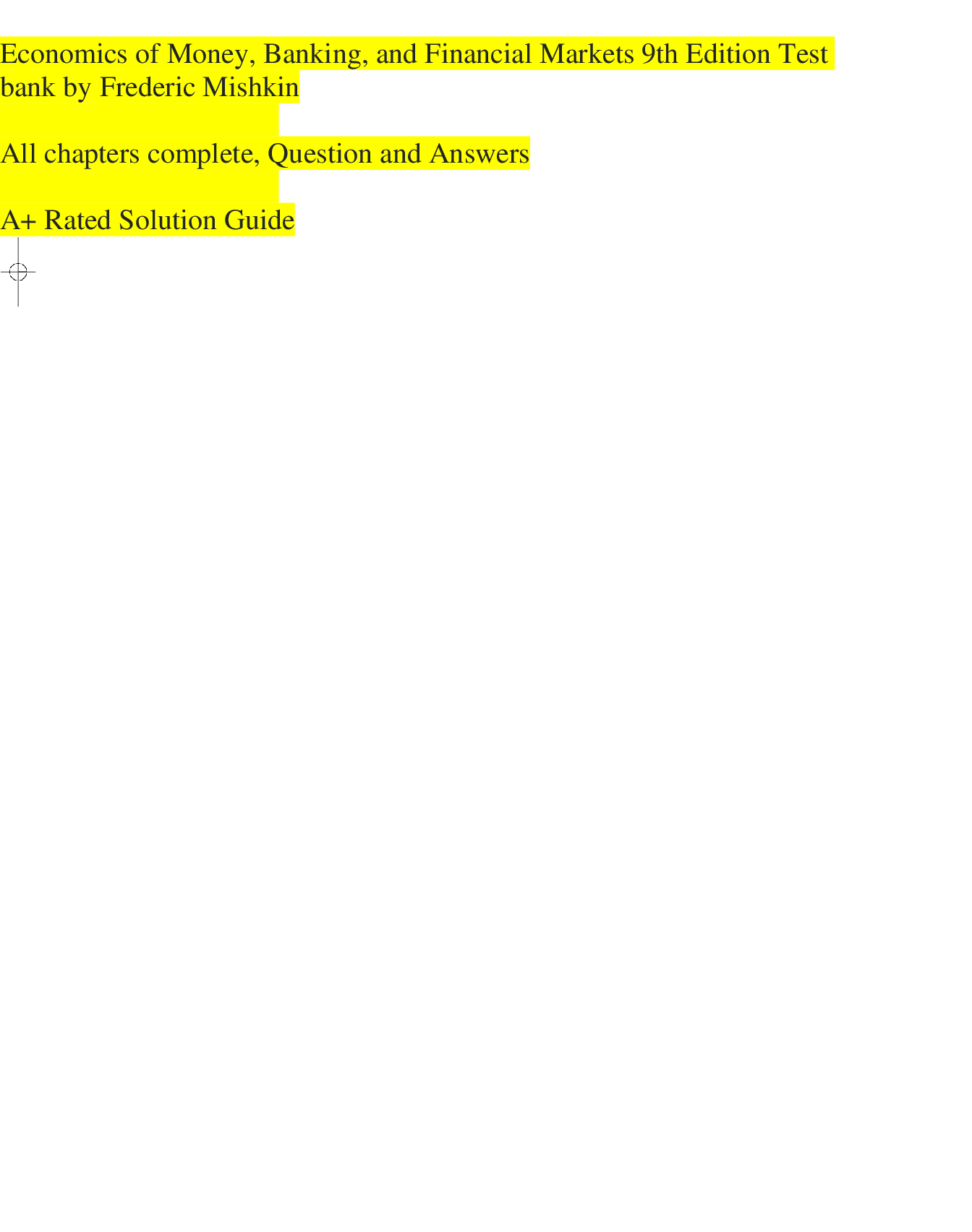Economics > TEST BANK > The Economics of Money, Banking, and Financial Markets (Pearson+) 13th Edition TEST BANK (All)
The Economics of Money, Banking, and Financial Markets (Pearson+) 13th Edition TEST BANK
Document Content and Description Below
Test Bank for Economics of Money, Banking, and Financial Markets, The, 13th Edition, 13e by Frederic S. Mishkin TEST BANK ISBN-13: 9780136894353 Full chapters included Part 1 Introduction 1 Why ... Study Money, Banking, and Financial Markets? Learning Objectives 1.1 Why Study Financial Markets? Debt Markets and Interest Rates The Stock Market 1.2 Why Study Financial Institutions and Banking? Structure of the Financial System Banks and Other Financial Institutions Financial Innovation Financial Crises 1.3 Why Study Money and Monetary Policy? Money and Business Cycles Money and Inflation Money and Interest Rates Conduct of Monetary Policy Fiscal Policy and Monetary Policy 1.4 Why Study International Finance? The Foreign Exchange Market The International Financial System 1.5 Money, Banking, and Financial Markets and Your Career 1.6 How We Will Study Money, Banking, and Financial Markets Concluding Remarks Summary Key Terms Questions Applied Problems Data Analysis Problems Appendix to Chapter 1 Defining Aggregate Output, Income, the Price Level, and the Inflation Rate Aggregate Output and Income Real Versus Nominal Magnitudes Aggregate Price Level Growth Rates and the Inflation Rate 2 An Overview of the Financial System Learning Objectives 2.1 Function of Financial Markets 2.2 Structure of Financial Markets Debt and Equity Markets Primary and Secondary Markets Exchanges and Over-the-Counter Markets Money and Capital Markets 2.3 Financial Market Instruments Money Market Instruments U.S. Treasury Bills Negotiable Bank Certificates of Deposit Commercial Paper Repurchase Agreements Federal (Fed) Funds Capital Market Instruments Stocks Mortgages and Mortgage-Backed Securities Corporate Bonds U.S. Government Securities U.S. Government Agency Securities State and Local Government Bonds Consumer and Bank Commercial Loans 2.4 Internationalization of Financial Markets International Bond Market, Eurobonds, and Eurocurrencies World Stock Markets 2.5 Function of Financial Intermediaries: Indirect Finance Transaction Costs Risk Sharing Asymmetric Information: Adverse Selection and Moral Hazard Economies of Scope and Conflicts of Interest 2.6 Types of Financial Intermediaries Depository Institutions Commercial Banks Savings and Loan Associations (S&Ls) and Mutual Savings Banks Credit Unions Contractual Savings Institutions Life Insurance Companies Fire and Casualty Insurance Companies Pension Funds and Government Retirement Funds Investment Intermediaries Finance Companies Mutual Funds Money Market Mutual Funds Hedge Funds Investment Banks 2.7 Regulation of the Financial System Increasing Information Available to Investors Ensuring the Soundness of Financial Intermediaries Restrictions on Entry Disclosure Restrictions on Assets and Activities Deposit Insurance Limits on Competition Restrictions on Interest Rates Financial Regulation Abroad Summary Key Terms Questions Applied Problems Data Analysis Problems 3 What Is Money? Learning Objectives 3.1 Meaning of Money 3.2 Functions of Money Medium of Exchange Unit of Account Store of Value 3.3 Evolution of the Payments System Commodity Money Fiat Money Checks Electronic Payment E-Money 3.4 Measuring Money The Federal Reserve’s Monetary Aggregates Summary Key Terms Questions Applied Problems Data Analysis Problems Part 2 Financial Markets 4 The Meaning of Interest Rates Learning Objectives 4.1 Measuring Interest Rates Present Value Four Types of Credit Market Instruments Yield to Maturity Simple Loan Fixed-Payment Loan Coupon Bond Discount Bond Summary 4.2 The Distinction Between Interest Rates and Returns Maturity and the Volatility of Bond Returns: Interest-Rate Risk Summary 4.3 The Distinction Between Real and Nominal Interest Rates Summary Key Terms Questions Applied Problems Data Analysis Problems 5 The Behavior of Interest Rates Learning Objectives 5.1 Determinants of Asset Demand Wealth Expected Returns Risk Liquidity Theory of Portfolio Choice 5.2 Supply and Demand in the Bond Market Demand Curve Supply Curve Market Equilibrium Supply and Demand Analysis 5.3 Changes in Equilibrium Interest Rates Shifts in the Demand for Bonds Wealth Expected Returns Risk Liquidity Shifts in the Supply of Bonds Expected Profitability of Investment Opportunities Expected Inflation Government Budget Deficits 5.4 Supply and Demand in the Market for Money: The Liquidity Preference Framework 5.5 Changes in Equilibrium Interest Rates in the Liquidity Preference Framework Shifts in the Demand for Money Income Effect Price-Level Effect Shifts in the Supply of Money Changes in Income Changes in the Price Level Changes in the Money Supply 5.6 Money and Interest Rates Summary Key Terms Questions Applied Problems Data Analysis Problems 6 The Risk and Term Structure of Interest Rates Learning Objectives 6.1 Risk Structure of Interest Rates Default Risk Liquidity Income Tax Considerations Summary 6.2 Term Structure of Interest Rates Expectations Theory Segmented Markets Theory Liquidity Premium and Preferred Habitat Theories Evidence on the Term Structure Summary Summary Key Terms Questions Applied Problems Data Analysis Problems 7 The Stock Market, the Theory of Rational Expectations, and the Efficient Market Hypothesis Learning Objectives 7.1 Computing the Price of Common Stock The One-Period Valuation Model The Generalized Dividend Valuation Model The Gordon Growth Model 7.2 How the Market Sets Stock Prices 7.3 The Theory of Rational Expectations Formal Statement of the Theory Rationale Behind the Theory Implications of the Theory 7.4 The Efficient Market Hypothesis: Rational Expectations in Financial Markets Rationale Behind the Hypothesis Random-Walk Behavior of Stock Prices How Valuable Are Reports Published by Investment Advisers? Should You Be Skeptical of Hot Tips? Do Stock Prices Always Rise When There Is Good News? Efficient Market Prescription for the Investor 7.5 Why the Efficient Market Hypothesis Does Not Imply That Financial Markets Are Efficient 7.6 Behavioral Finance Summary Key Terms Questions Applied Problems Data Analysis Problems Part 3 Financial Institutions 8 An Economic Analysis of Financial Structure Learning Objectives 8.1 Basic Facts About Financial Structure Throughout The World 8.2 Transaction Costs How Transaction Costs Influence Financial Structure How Financial Intermediaries Reduce Transaction Costs Economies of Scale Expertise 8.3 Asymmetric Information: Adverse Selection and Moral Hazard 8.4 The Lemons Problem: How Adverse Selection Influences Financial Structure Lemons in the Stock and Bond Markets Tools to Help Solve Adverse Selection Problems Private Production and Sale of Information Government Regulation to Increase Information Financial Intermediation Collateral and Net Worth Summary 8.5 How Moral Hazard Affects the Choice Between Debt and Equity Contracts Moral Hazard in Equity Contracts: The Principal–Agent Problem Tools to Help Solve the Principal–Agent Problem Production of Information: Monitoring Government Regulation to Increase Information Financial Intermediation Debt Contracts 8.6 How Moral Hazard Influences Financial Structure in Debt Markets Tools to Help Solve Moral Hazard in Debt Contracts Net Worth and Collateral Monitoring and Enforcement of Restrictive Covenants Financial Intermediation Summary Summary Key Terms Questions Applied Problems Data Analysis Problems 9 Banking and the Management of Financial Institutions Learning Objectives 9.1 The Bank Balance Sheet Liabilities Checkable Deposits Nontransaction Deposits Borrowings Bank Capital Assets Reserves Cash Items in Process of Collection Deposits at Other Banks Securities Loans Other Assets 9.2 Basic Banking 9.3 General Principles of Bank Management Liquidity Management and the Role of Reserves Asset Management Liability Management Capital Adequacy Management How Bank Capital Helps Prevent Bank Failure How the Amount of Bank Capital Affects Returns to Equity Holders Trade-Off Between Safety and Returns to Equity Holders Bank Capital Requirements 9.4 Managing Credit Risk Screening and Monitoring Screening Specialization in Lending Monitoring and Enforcement of Restrictive Covenants Long-Term Customer Relationships Loan Commitments Collateral and Compensating Balances Credit Rationing 9.5 Managing Interest-Rate Risk Gap and Duration Analysis 9.6 Off-Balance-Sheet Activities Loan Sales Generation of Fee Income Trading Activities and Risk Management Techniques Summary Key Terms Questions Applied Problems Data Analysis Problem 10 Economic Analysis of Financial Regulation Learning Objectives 10.1 Asymmetric Information as a Rationale for Financial Regulation Government Safety Net Bank Panics and the Need for Deposit Insurance Other Forms of the Government Safety Net Drawbacks of the Government Safety Net Moral Hazard and the Government Safety Net Adverse Selection and the Government Safety Net “Too Big to Fail” Financial Consolidation and the Government Safety Net 10.2 Types of Financial Regulation Restrictions on Asset Holdings Capital Requirements Prompt Corrective Action Financial Supervision: Chartering and Examination Assessment of Risk Management Disclosure Requirements Consumer Protection Restrictions on Competition Summary Summary Key Terms Questions Applied Problems Data Analysis Problems 11 Banking Industry: Structure and Competition Learning Objectives 11.1 Historical Development of the Banking System Multiple Regulatory Agencies 11.2 Financial Innovation and the Growth of the “Shadow Banking System” Responses to Changes in Demand Conditions: Interest-Rate Volatility Adjustable-Rate Mortgages Financial Derivatives Responses to Changes in Supply Conditions: Information Technology Bank Credit and Debit Cards Electronic Banking Junk Bonds Commercial Paper Market Securitization and the Shadow Banking System How the Shadow Banking System Works Subprime Mortgage Market Avoidance of Existing Regulations Money Market Mutual Funds Sweep Accounts Financial Innovation and the Decline of Traditional Banking Decline in Cost Advantages in Acquiring Funds (Liabilities) Decline in Income Advantages on Uses of Funds (Assets) Banks’ Responses Decline of Traditional Banking in Other Industrialized Countries 11.3 Structure of the U.S. Commercial Banking Industry Restrictions on Branching Response to Branching Restrictions Bank Holding Companies Automated Teller Machines 11.4 Bank Consolidation and Nationwide Banking The Riegle-Neal Interstate Banking and Branching Efficiency Act of 1994 What Will the Structure of the U.S. Banking Industry Look Like in the Future? Are Bank Consolidation and Nationwide Banking Good Things? 11.5 Separation of Banking and Other Financial Service Industries Erosion of Glass-Steagall The Gramm-Leach-Bliley Financial Services Modernization Act of 1999: Repeal of Glass-Steagall Implications for Financial Consolidation Separation of Banking and Other Financial Services Industries Throughout the World 11.6 Thrift Industry: Regulation and Structure Savings and Loan Associations Mutual Savings Banks Credit Unions 11.7 International Banking Eurodollar Market Structure of U.S. Banking Overseas Foreign Banks in the United States Summary Key Terms Questions Data Analysis Problems 12 Financial Crises Learning Objectives 12.1 What is a Financial Crisis? 12.2 Dynamics of Financial Crises Stage One: Initial Phase Credit Boom and Bust Asset-Price Boom and Bust Increase in Uncertainty Stage Two: Banking Crisis Stage Three: Debt Deflation 12.3 The Global Financial Crisis of 2007–2009 Causes of the 2007–2009 Financial Crisis Financial Innovation in the Mortgage Markets Agency Problems in the Mortgage Markets Asymmetric Information and Credit-Rating Agencies Effects of the 2007–2009 Financial Crisis Residential Housing Prices: Boom and Bust Deterioration of Financial Institutions’ Balance Sheets Run on the Shadow Banking System Global Financial Markets Failure of High-Profile Firms Height of the 2007–2009 Financial Crisis Government Intervention and the Recovery 12.4 Response of Financial Regulation Macroprudential Versus Microprudential Supervision Dodd-Frank Wall Street Reform and Consumer Protection Act of 2010 Consumer Protection Annual Stress Tests Resolution Authority Limits on Federal Reserve Lending Systemic Risk Regulation Volcker Rule Derivatives 12.5 Too-Big-to-Fail and Future Regulation What Can Be Done About the Too-Big-to-Fail Problem? Break Up Large, Systemically Important Financial Institutions Higher Capital Requirements Leave It to Dodd-Frank Beyond Dodd-Frank: Where Might Regulation Head in the Future? Consumer Protection Resolution Authority Volcker Rule Derivatives Trading Government-Sponsored Enterprises (GSEs) Summary Key Terms Questions Data Analysis Problems Part 4 Central Banking and the Conduct of Monetary Policy 13 Central Banks and the Federal Reserve System Learning Objectives 13.1 Origins of the Federal Reserve System 13.2 Structure of the Federal Reserve System Federal Reserve Banks Member Banks Board of Governors of the Federal Reserve System Federal Open Market Committee (FOMC) Why the Chair of the Board of Governors Really Runs the Show 13.3 How Independent is the Fed? 13.4 Should the Fed be Independent? The Case for Independence The Case Against Independence Central Bank Independence and Macroeconomic Performance Throughout the World 13.5 Explaining Central Bank Behavior 13.6 Structure and Independence of the European Central Bank Differences Between the European System of Central Banks and the Federal Reserve System Governing Council How Independent Is the ECB? 13.7 Structure and Independence of Other Foreign Central Banks Bank of Canada Bank of England Bank of Japan The Trend Toward Greater Independence Summary Key Terms Questions Data Analysis Problems 14 The Money Supply Process Learning Objectives 14.1 Three Players in the Money Supply Process 14.2 The Fed’s Balance Sheet Liabilities Assets 14.3 Control of the Monetary Base Federal Reserve Open Market Operations Open Market Purchase Open Market Sale Shifts from Deposits into Currency Loans to Financial Institutions Other Factors That Affect the Monetary Base Overview of the Fed’s Ability to Control the Monetary Base 14.4 Multiple Deposit Creation: A Simple Model Deposit Creation: The Single Bank Deposit Creation: The Banking System Deriving the Formula for Multiple Deposit Creation Critique of the Simple Model 14.5 Factors that Determine the Money Supply Changes in the Nonborrowed Monetary Base, MBn Changes in Borrowed Reserves, BR, from the Fed Changes in the Required Reserve Ratio, rr Changes in Excess Reserves Changes in Currency Holdings 14.6 Overview of the Money Supply Process 14.7 The Money Multiplier Deriving the Money Multiplier Intuition Behind the Money Multiplier Money Supply Response to Changes in the Factors Summary Key Terms Questions Applied Problems Data Analysis Problems 15 Tools of Monetary Policy Learning Objectives 15.1 The Market for Reserves and the Federal Funds Rate Demand and Supply in the Market for Reserves Demand Curve Supply Curve Market Equilibrium How Changes in the Tools of Monetary Policy Affect the Federal Funds Rate Open Market Operations Discount Lending Reserve Requirements Interest on Excess Reserves 15.2 Conventional Monetary Policy Tools Open Market Operations Discount Policy and the Lender of Last Resort Operation of the Discount Window Lender of Last Resort Reserve Requirements Interest on Excess Reserves 15.3 Nonconventional Monetary Policy Tools and Quantitative Easing in the wake of the global financial crisis and the coronavirus pandemic Liquidity Provision Large-Scale Asset Purchases Quantitative Easing Versus Credit Easing Forward Guidance Negative Interest Rates on Banks’ Deposits 15.4 Monetary Policy Tools of the European Central Bank Open Market Operations Lending to Banks Interest on Excess Reserves Reserve Requirements Summary Key Terms Questions Applied Problems Data Analysis Problems 16 The Conduct of Monetary Policy: Strategy and Tactics Learning Objectives 16.1 The Price Stability Goal and the Nominal Anchor The Role of a Nominal Anchor The Time-Inconsistency Problem 16.2 Other Goals of Monetary Policy High Employment and Output Stability Economic Growth Stability of Financial Markets Interest-Rate Stability Stability in Foreign Exchange Markets 16.3 Should Price Stability be the Primary Goal of Monetary Policy? Hierarchical Versus Dual Mandates Price Stability as the Primary, Long-Run Goal of Monetary Policy 16.4 Inflation Targeting Inflation Targeting in New Zealand, Canada, and the United Kingdom New Zealand Canada United Kingdom Advantages of Inflation Targeting Reduction of the Time-Inconsistency Problem Increased Transparency Increased Accountability Consistency with Democratic Principles Improved Performance Disadvantages of Inflation Targeting Delayed Signaling Too Much Rigidity Potential for Increased Output Fluctuations Low Economic Growth 16.5 The Evolution of the Federal Reserve’s Monetary Policy Strategy The Fed’s “Just Do It” Monetary Policy Strategy The Long Road to Inflation Targeting 16.6 Lessons for Monetary Policy Strategy from the Global Financial Crisis Implications for Inflation Targeting Level of the Inflation Target Flexibility of Inflation Targeting 16.7 Should Central Banks Try to Stop Asset-Price Bubbles? Two Types of Asset-Price Bubbles Credit-Driven Bubbles Bubbles Driven Solely by Irrational Exuberance The Debate over Whether Central Banks Should Try to Pop Bubbles Con: Why Central Banks Should Not Try to Prick Asset-Price Bubbles but Should Just Clean Up After They Burst Pro: Why Central Banks Should Try to Pop Bubbles Macroprudential Policies Monetary Policy 16.8 Tactics: Choosing the Policy Instrument Criteria for Choosing the Policy Instrument Observability and Measurability Controllability Predictable Effect on Goals 16.9 Tactics: The Taylor Rule Summary Key Terms Questions Applied Problems Data Analysis Problems Part 5 International Finance and Monetary Policy 17 The Foreign Exchange Market Learning Objectives 17.1 Foreign Exchange Market What Are Foreign Exchange Rates? Why Are Exchange Rates Important? How Is Foreign Exchange Traded? 17.2 Exchange Rates in the Long Run Theory of Purchasing Power Parity Evidence on Purchasing Power Parity Why the Theory of Purchasing Power Parity Cannot Fully Explain Exchange Rates Factors That Affect Exchange Rates in the Long Run Relative Price Levels Trade Barriers Preferences for Domestic Versus Foreign Goods Productivity 17.3 Exchange Rates in the Short Run: A Supply and Demand Analysis Supply Curve for Domestic Assets Demand Curve for Domestic Assets Equilibrium in the Foreign Exchange Market 17.4 Explaining Changes in Exchange Rates Shifts in the Demand for Domestic Assets Domestic Interest Rate, iD Foreign Interest Rate, iF Changes in the Expected Future Exchange Rate, Et+1e Recap: Factors That Change the Exchange Rate Summary Key Terms Questions Applied Problems Data Analysis Problems 18 The International Financial System Learning Objectives 18.1 Intervention in the Foreign Exchange Market Foreign Exchange Intervention and the Money Supply Unsterilized Intervention Sterilized Intervention 18.2 Balance of Payments Current Account Financial Account 18.3 Exchange Rate Regimes in the International Financial System Gold Standard The Bretton Woods System How a Fixed Exchange Rate Regime Works Devaluation and Revaluation Perfect Capital Mobility Speculative Attacks The Policy Trilemma Monetary Unions Managed Float 18.4 Capital Controls Controls on Capital Outflows Controls on Capital Inflows 18.5 The Role of the IMF Should the IMF Act as an International Lender of Last Resort? 18.6 International Considerations and Monetary Policy Direct Effects of the Foreign Exchange Market on Monetary Policy Exchange Rate Considerations 18.7 To Peg or Not to Peg: Exchange-Rate Targeting as an Alternative Monetary Policy Strategy Advantages of Exchange-Rate Targeting Disadvantages of Exchange-Rate Targeting When Is Exchange-Rate Targeting Desirable for Industrialized Countries? When Is Exchange-Rate Targeting Desirable for Emerging Market Countries? Currency Boards Dollarization Summary Key Terms Questions Applied Problems Data Analysis Problems Part 6 Monetary Theory 19 Quantity Theory, Inflation, and the Demand for Money Learning Objectives 19.1 Quantity Theory of Money Velocity of Money and Equation of Exchange Determinants of Velocity Demand for Money From the Equation of Exchange to the Quantity Theory of Money Quantity Theory and the Price Level Quantity Theory and Inflation 19.2 Budget Deficits and Inflation Government Budget Constraint Hyperinflation 19.3 Keynesian Theories of Money Demand Transactions Motive Precautionary Motive Speculative Motive Putting the Three Motives Together 19.4 Portfolio Theories of Money Demand Theory of Portfolio Choice and Keynesian Liquidity Preference Other Factors That Affect the Demand for Money Wealth Risk Liquidity of Other Assets Summary 19.5 Empirical Evidence on the Demand for Money Interest Rates and Money Demand Stability of Money Demand Summary Key Terms Questions Applied Problems Data Analysis Problems 20 The IS Curve Learning Objectives 20.1 Planned Expenditure and Aggregate Demand 20.2 The Components of Aggregate Demand Consumption Expenditure Consumption Function Planned Investment Spending Fixed Investment Inventory Investment Planned Investment Spending and Real Interest Rates Planned Investment and Business Expectations Investment Function Government Purchases and Taxes Government Purchases Taxes Net Exports Real Interest Rates and Net Exports Autonomous Net Exports Net Export Function 20.3 Goods Market Equilibrium Solving for Goods Market Equilibrium Deriving the IS Curve 20.4 Understanding the IS Curve What the IS Curve Tells Us: Intuition What the IS Curve Tells Us: Numerical Example Why the Economy Heads Toward Equilibrium 20.5 Factors That Shift the IS Curve Changes in Government Purchases Changes in Taxes Changes in Autonomous Spending Autonomous Consumption Autonomous Investment Spending Autonomous Net Exports Changes in Financial Frictions Summary of Factors That Shift the IS Curve Summary Key Terms Questions Applied Problems Data Analysis Problems 21 The Monetary Policy and Aggregate Demand Curves Learning Objectives 21.1 The Federal Reserve and Monetary Policy 21.2 The Monetary Policy Curve Why the Monetary Policy Curve Has an Upward Slope Shifts in the MP Curve Movements Along Versus Shifts in the MP Curve 21.3 The Aggregate Demand Curve Deriving the Aggregate Demand Curve Graphically Factors That Shift the Aggregate Demand Curve Shifts in the IS Curve Shifts in the MP Curve Summary Key Terms Questions Applied Problems Data Analysis Problems 22 Aggregate Demand and Supply Analysis Learning Objectives 22.1 Business Cycles and Inflation Business Cycles Inflation 22.2 Aggregate Demand Components of Aggregate Demand Deriving the Aggregate Demand Curve Factors That Shift the Aggregate Demand Curve 22.3 Aggregate Supply Long-Run Aggregate Supply Curve Short-Run Aggregate Supply Curve Expected Inflation, πe Output Gap Inflation (Supply) Shocks Short-Run Aggregate Supply Curve Why the Short-Run Aggregate Supply Curve Is Upward-Sloping Price Stickiness and the Short-Run Aggregate Supply Curve 22.4 Shifts in the Aggregate Supply Curves Shifts in the Long-Run Aggregate Supply Curve Shifts in the Short-Run Aggregate Supply Curve Expected Inflation Inflation Shock Persistent Output Gap 22.5 Equilibrium in Aggregate Demand and Supply Analysis Short-Run Equilibrium Aggregate Demand and Supply Analysis Using an Aggregate Output Index Calculating an Aggregate Output Index. An AD/AS Diagram with an Aggregate Output Index How the Short-Run Equilibrium Moves to the Long-Run Equilibrium over Time Self-Correcting Mechanism 22.6 Changes in Equilibrium: Aggregate Demand Shocks 22.7 Changes in Equilibrium: Aggregate Supply (Inflation) Shocks 22.8 Conclusions from Aggregate Demand and Supply Analysis Summary Key Terms Questions Applied Problems Data Analysis Problems Appendix To Chapter 22 The Phillips Curve and the Short-Run Aggregate Supply Curve 22.A1 The Phillips Curve Phillips Curve Analysis in the 1960s The Friedman-Phelps Phillips Curve Analysis The Phillips Curve After the 1960s The Modern Phillips Curve The Modern Phillips Curve with Adaptive (Backward-Looking) Expectations 22.A2 The Short-Run Aggregate Supply Curve 23 Monetary Policy Theory Learning Objectives 23.1 Response of Monetary Policy to Shocks Response to an Aggregate Demand Shock No Policy Response Policy Stabilizes Economic Activity and Inflation in the Short Run Response to a Supply Shock No Policy Response Policy Stabilizes Inflation in the Short Run Policy Stabilizes Economic Activity in the Short Run The Bottom Line: The Relationship Between Stabilizing Inflation and Stabilizing Economic Activity 23.2 How Actively Should Policymakers Try to Stabilize Economic Activity? Lags and Policy Implementation 23.3 Inflation: Always and Everywhere a Monetary Phenomenon 23.4 Causes of Inflationary Monetary Policy High Employment Targets and Inflation Cost-Push Inflation Demand-Pull Inflation Cost-Push Versus Demand-Pull Inflation 23.5 Monetary Policy at the Effective Lower Bound Deriving the Aggregate Demand Curve with the Effective Lower Bound The Disappearance of the Self-Correcting Mechanism at the Effective Lower Bound Liquidity Provision Asset Purchases and Quantitative Easing Management of Expectations Summary Key Terms Questions Applied Problems Data Analysis Problems 24 The Role of Expectations in Monetary Policy Learning Objectives 24.1 Lucas Critique of Policy Evaluation Econometric Policy Evaluation 24.2 Policy Conduct: Rules or Discretion? Discretion and the Time-Inconsistency Problem Types of Rules The Case for Rules The Case for Discretion Constrained Discretion 24.3 The Role of Credibility and a Nominal Anchor Benefits of a Credible Nominal Anchor Credibility and Aggregate Demand Shocks Positive Demand Shock Negative Demand Shock Credibility and Aggregate Supply Shocks Credibility and Anti-Inflation Policy 24.4 Approaches to Establishing Central Bank Credibility Nominal GDP Targeting Appoint “Conservative” Central Bankers Summary Key Terms Questions Applied Problems Data Analysis Problems 25 Transmission Mechanisms of Monetary Policy Learning Objectives 25.1 Transmission Mechanisms of Monetary Policy Traditional Interest-Rate Channels Other Asset Price Channels Exchange Rate Effects on Net Exports Tobin’s q Theory Wealth Effects Credit View Bank Lending Channel Balance Sheet Channel Cash Flow Channel Unanticipated Price Level Channel Household Liquidity Effects Why Are Credit Channels Likely to Be Important? 25.2 Lessons for Monetary Policy Summary Key Terms Questions Applied Problems Data Analysis Problems [Show More]
Last updated: 3 months ago
Preview 1 out of 708 pages
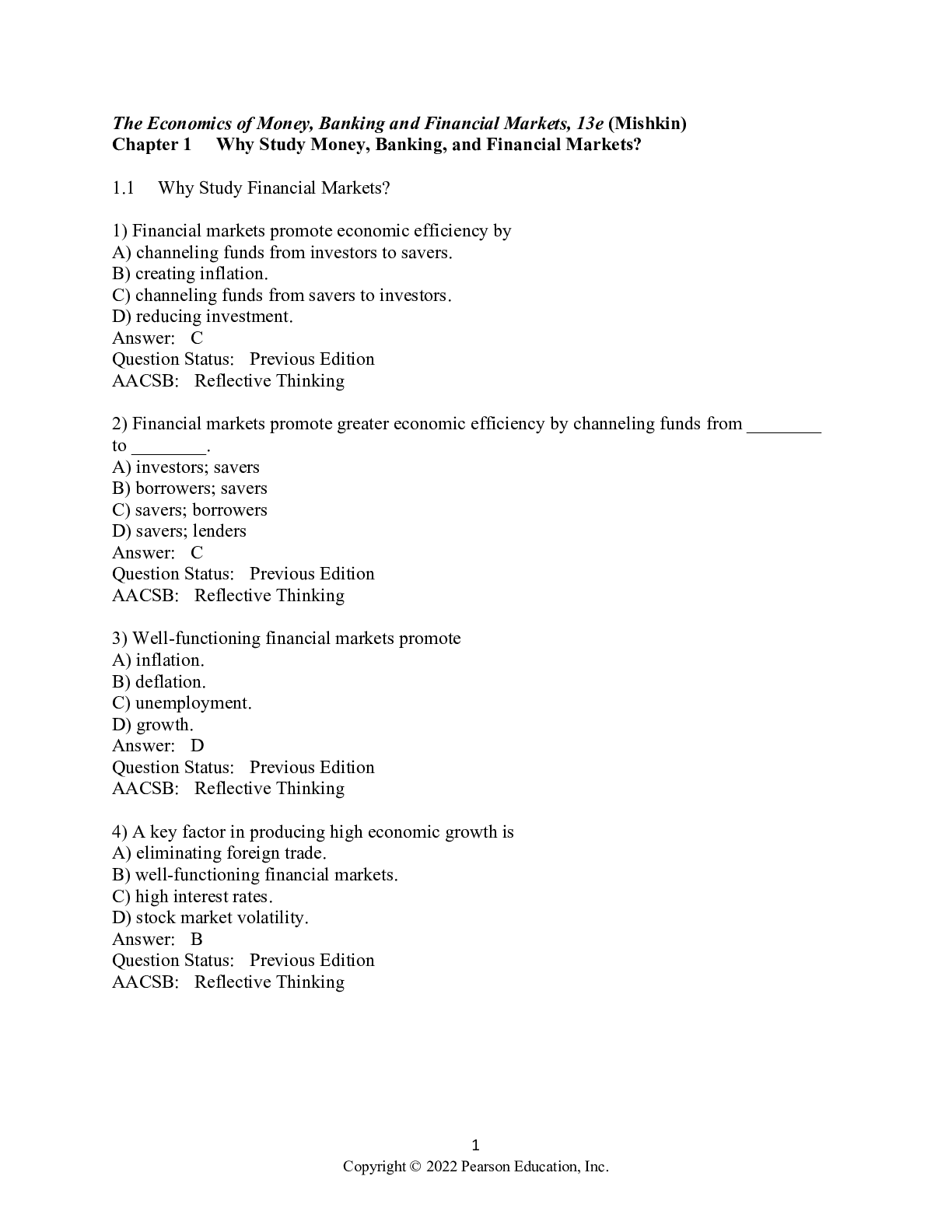
Reviews( 0 )
Document information
Connected school, study & course
About the document
Uploaded On
Sep 02, 2022
Number of pages
708
Written in
Additional information
This document has been written for:
Uploaded
Sep 02, 2022
Downloads
1
Views
132


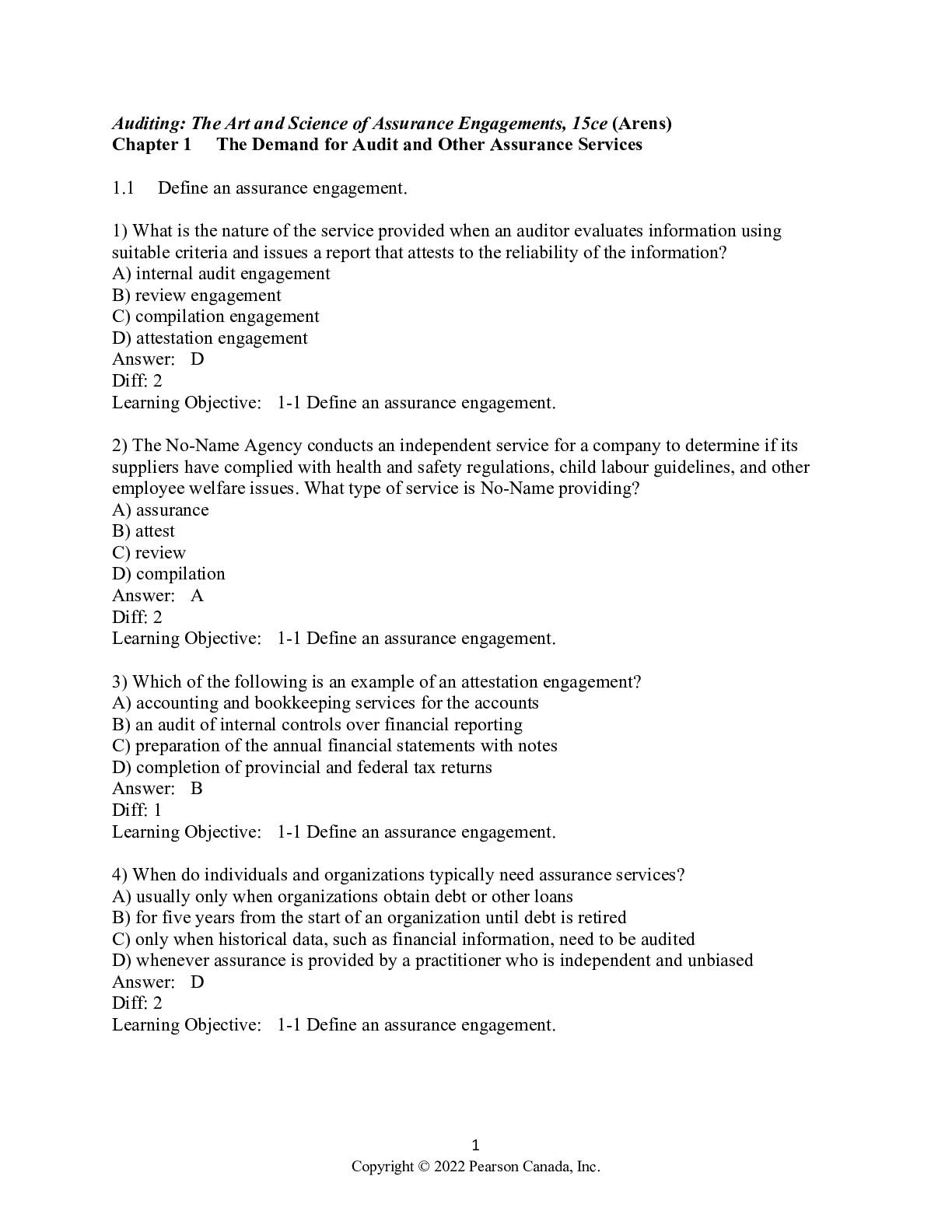
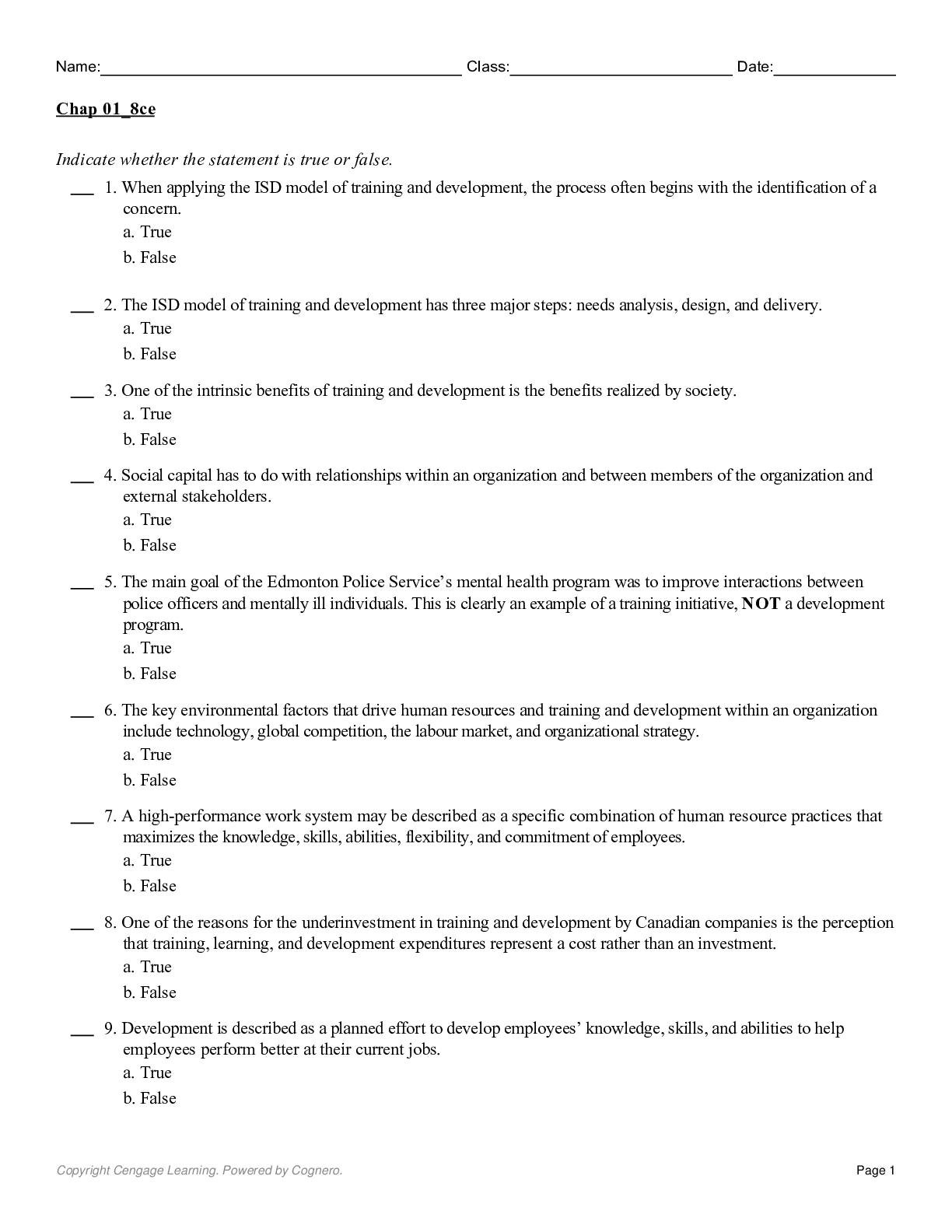
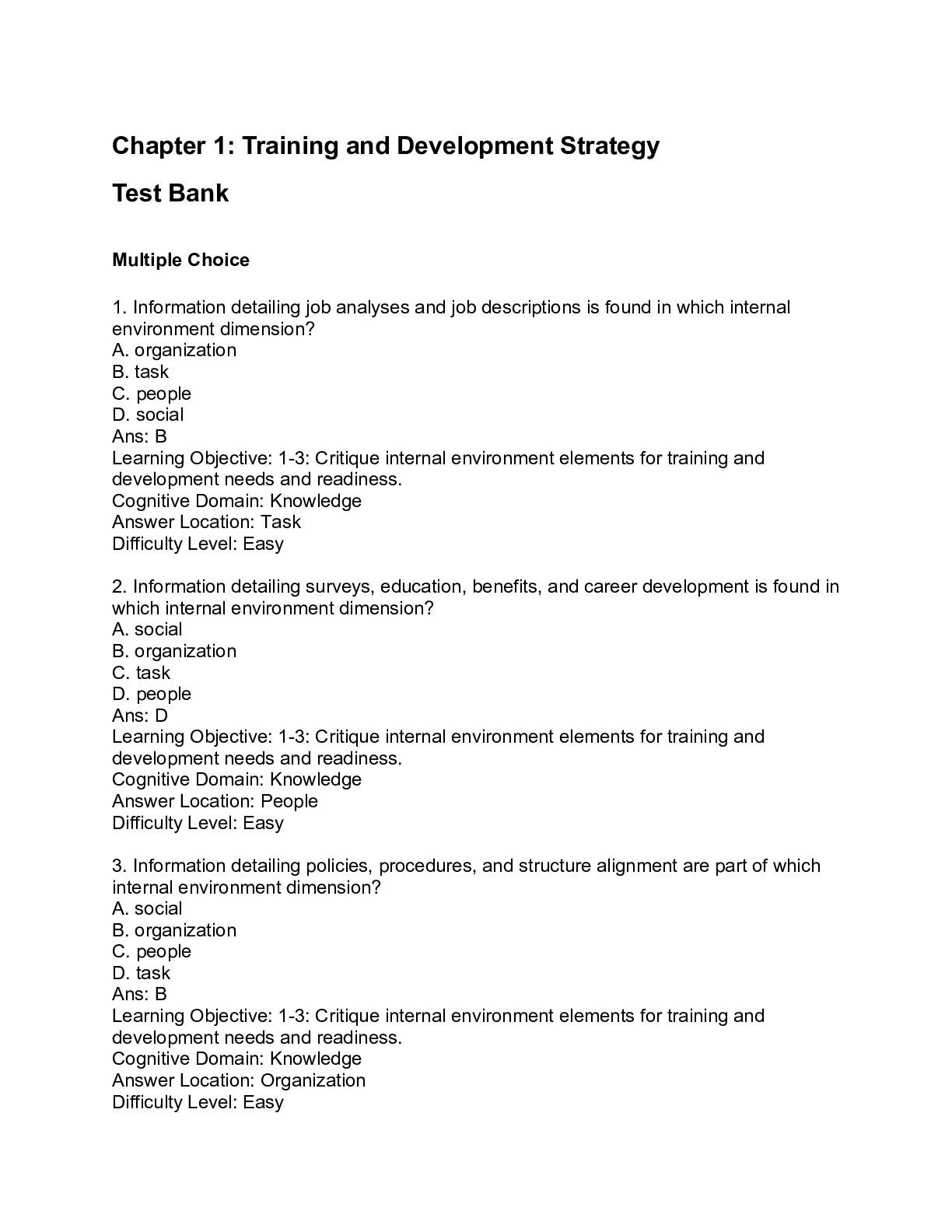
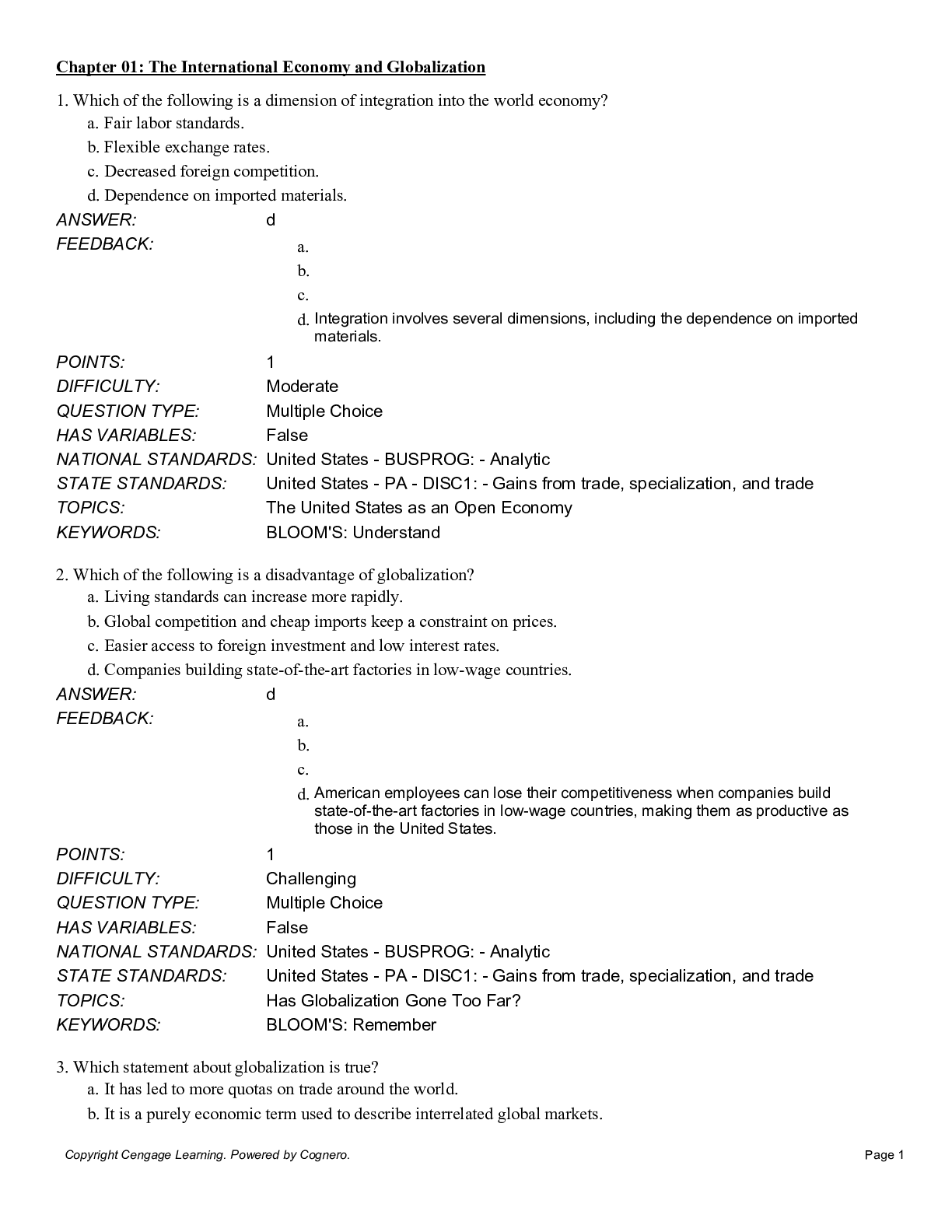
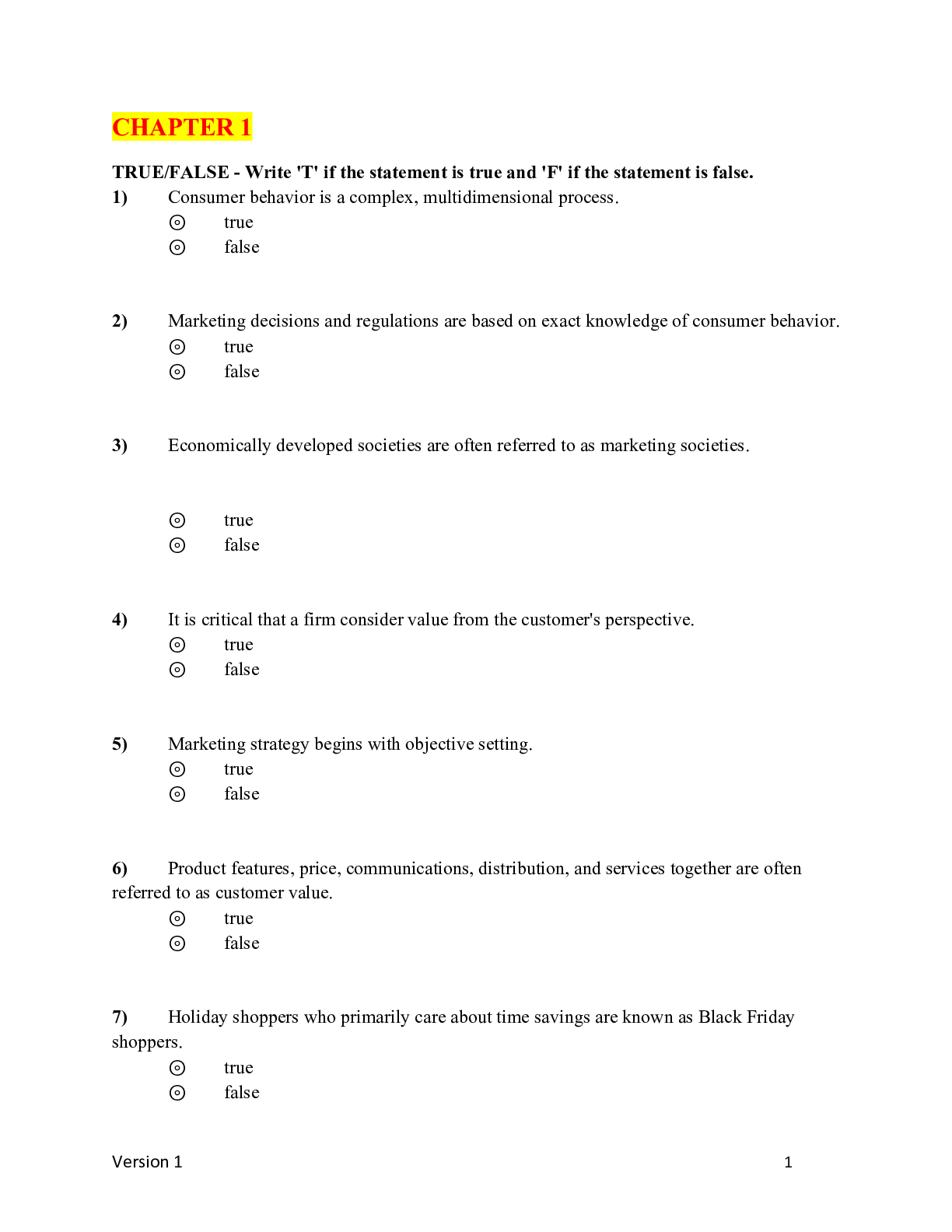
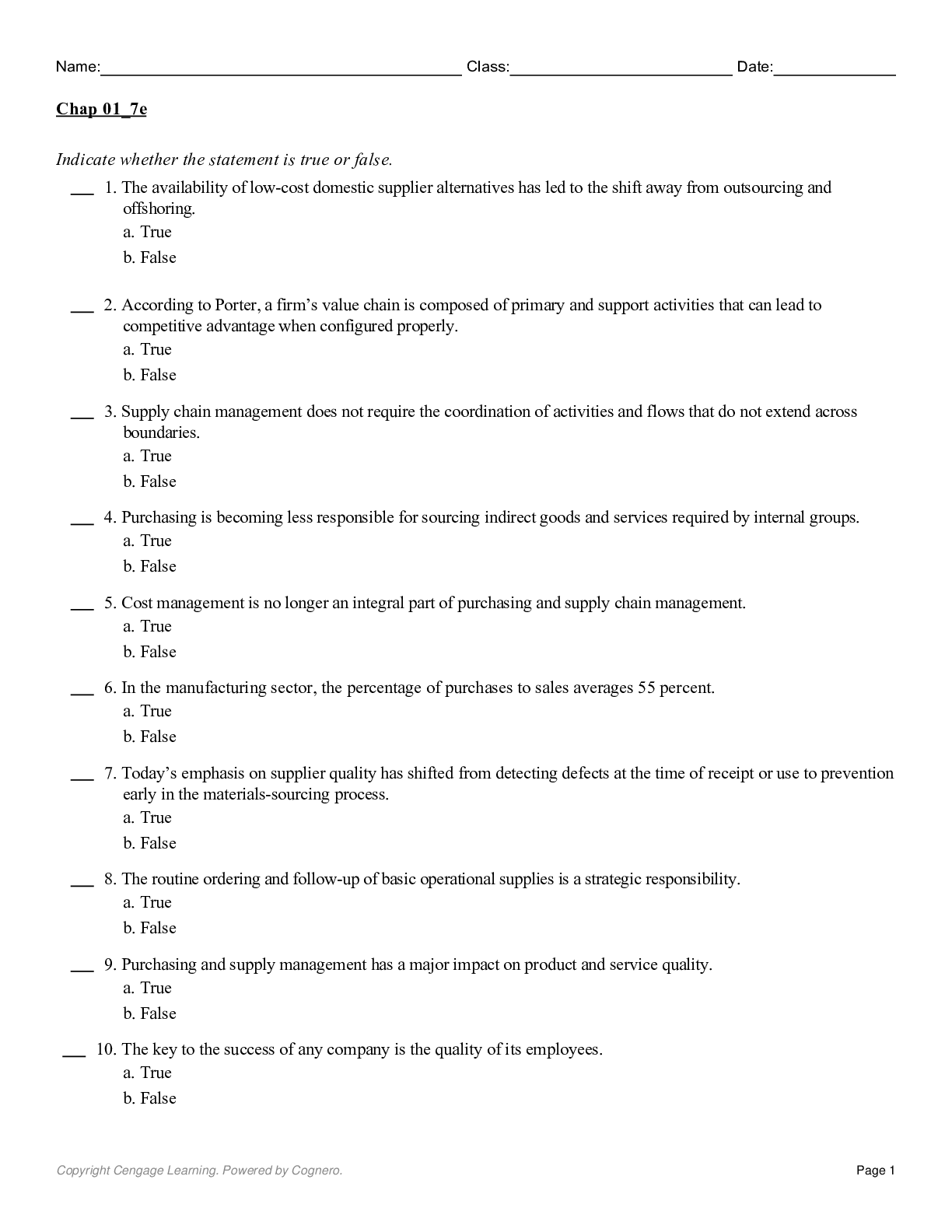
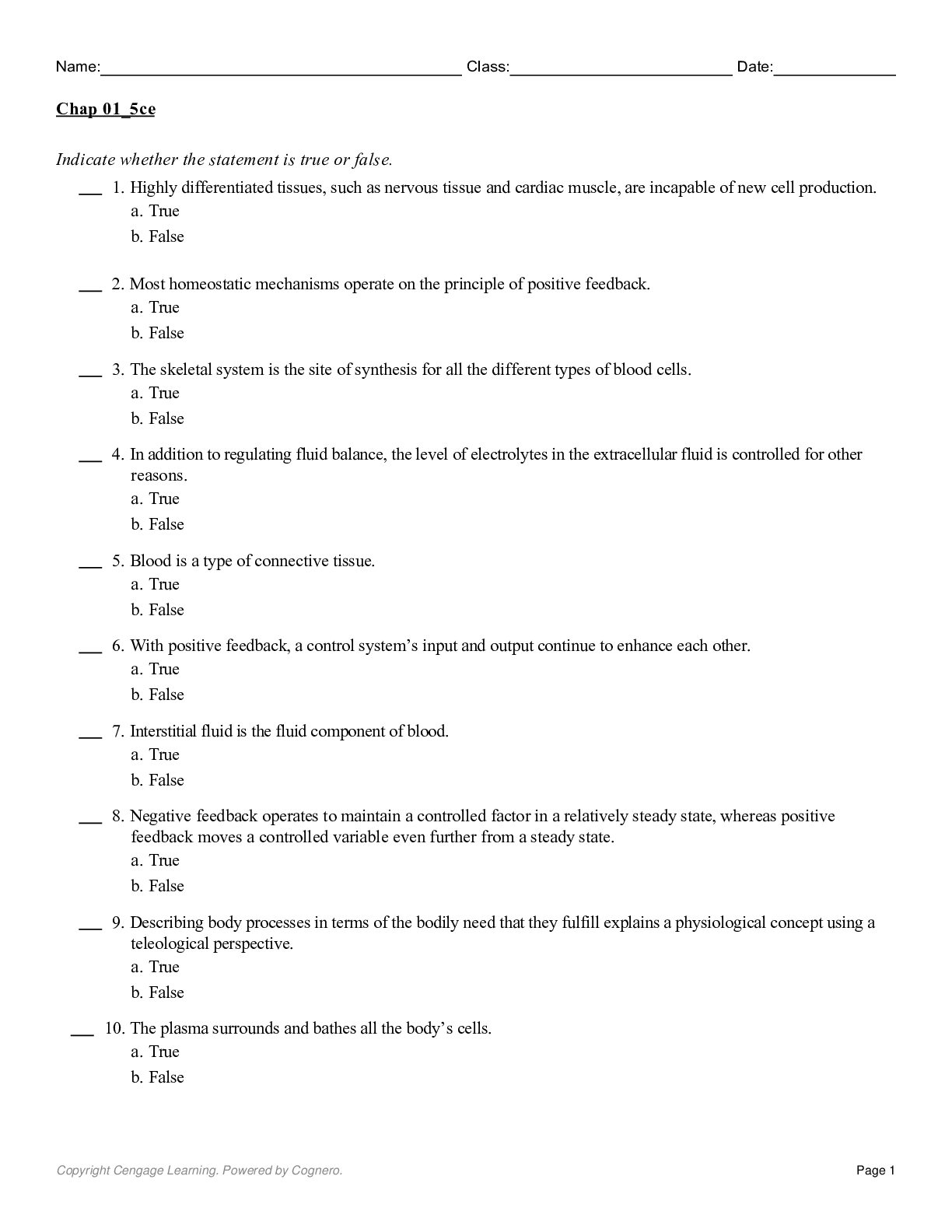

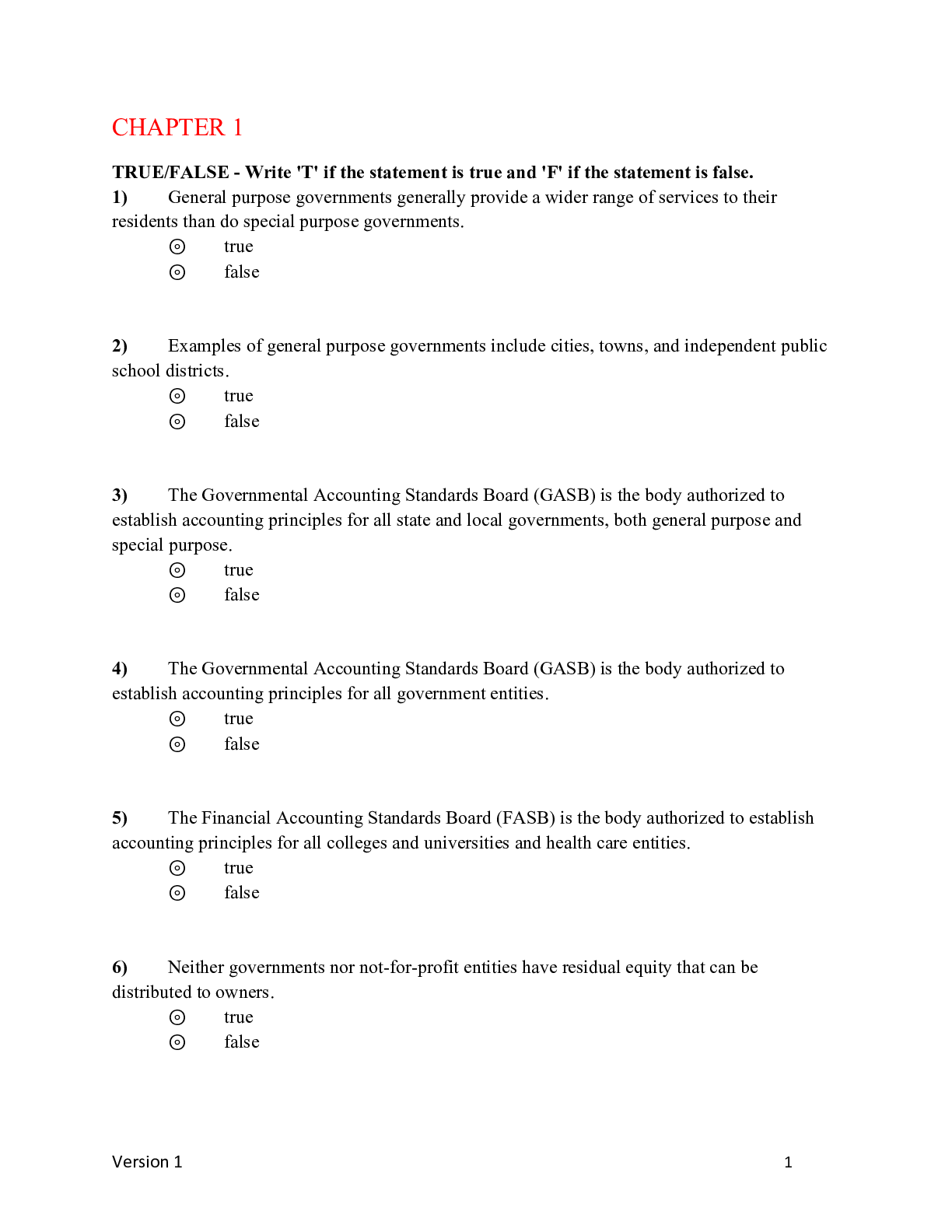
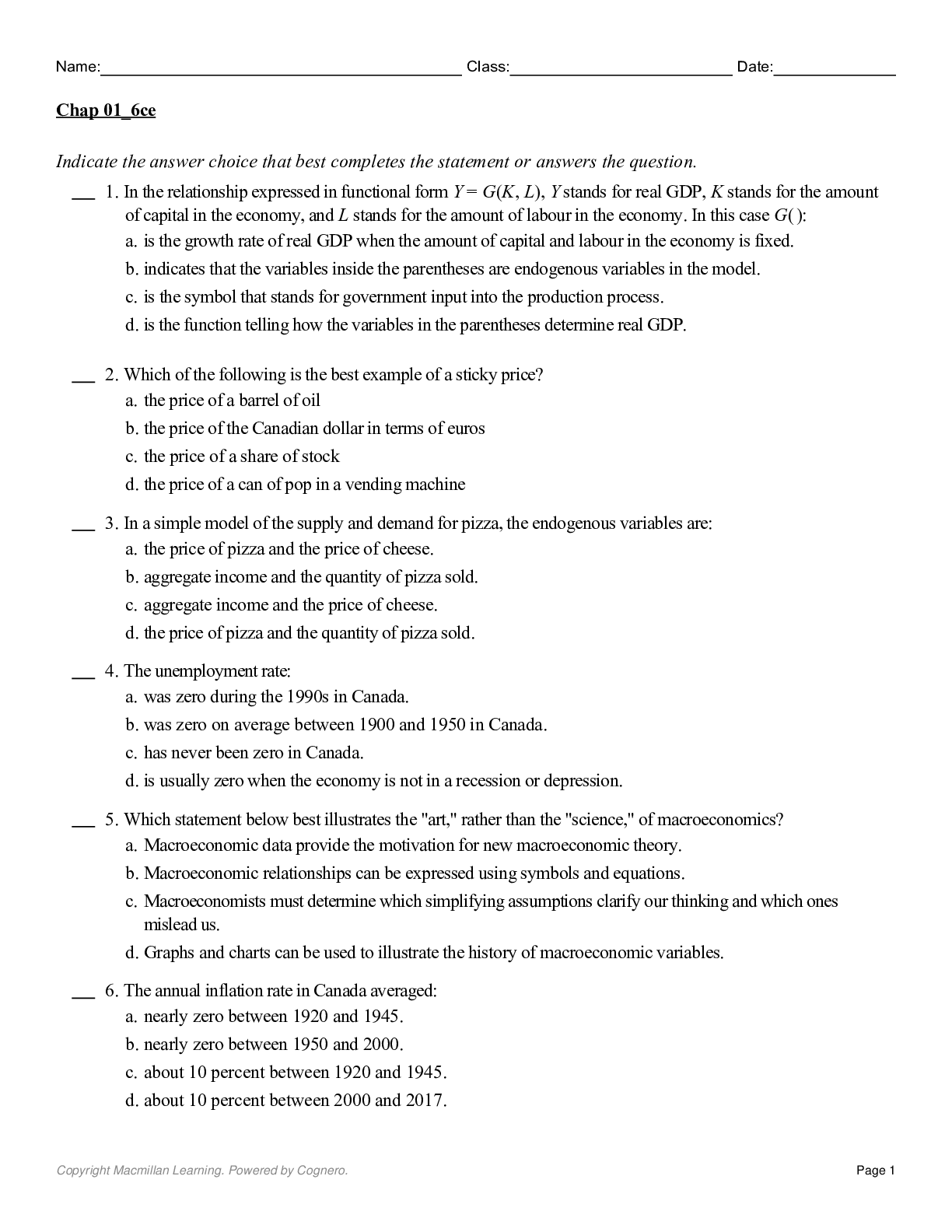
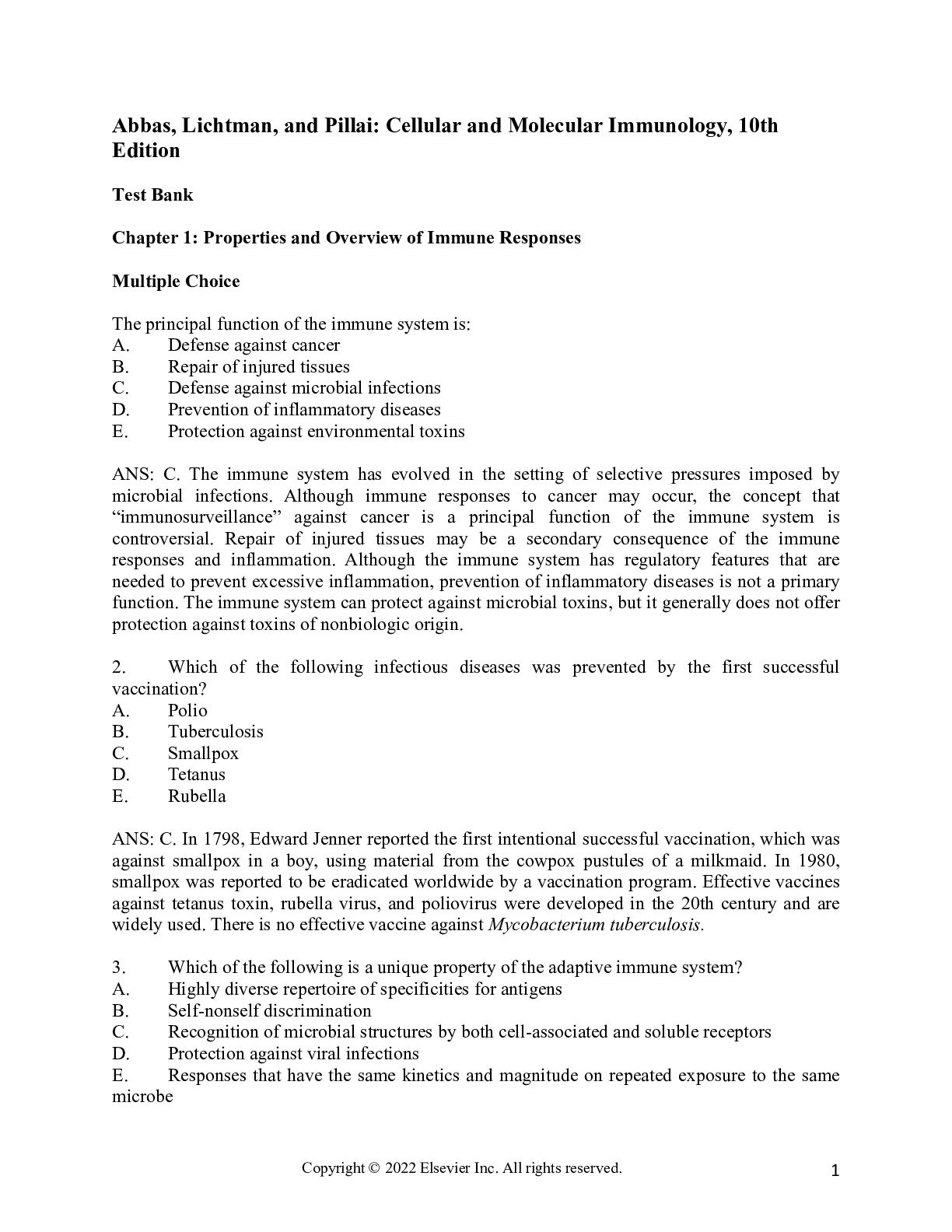

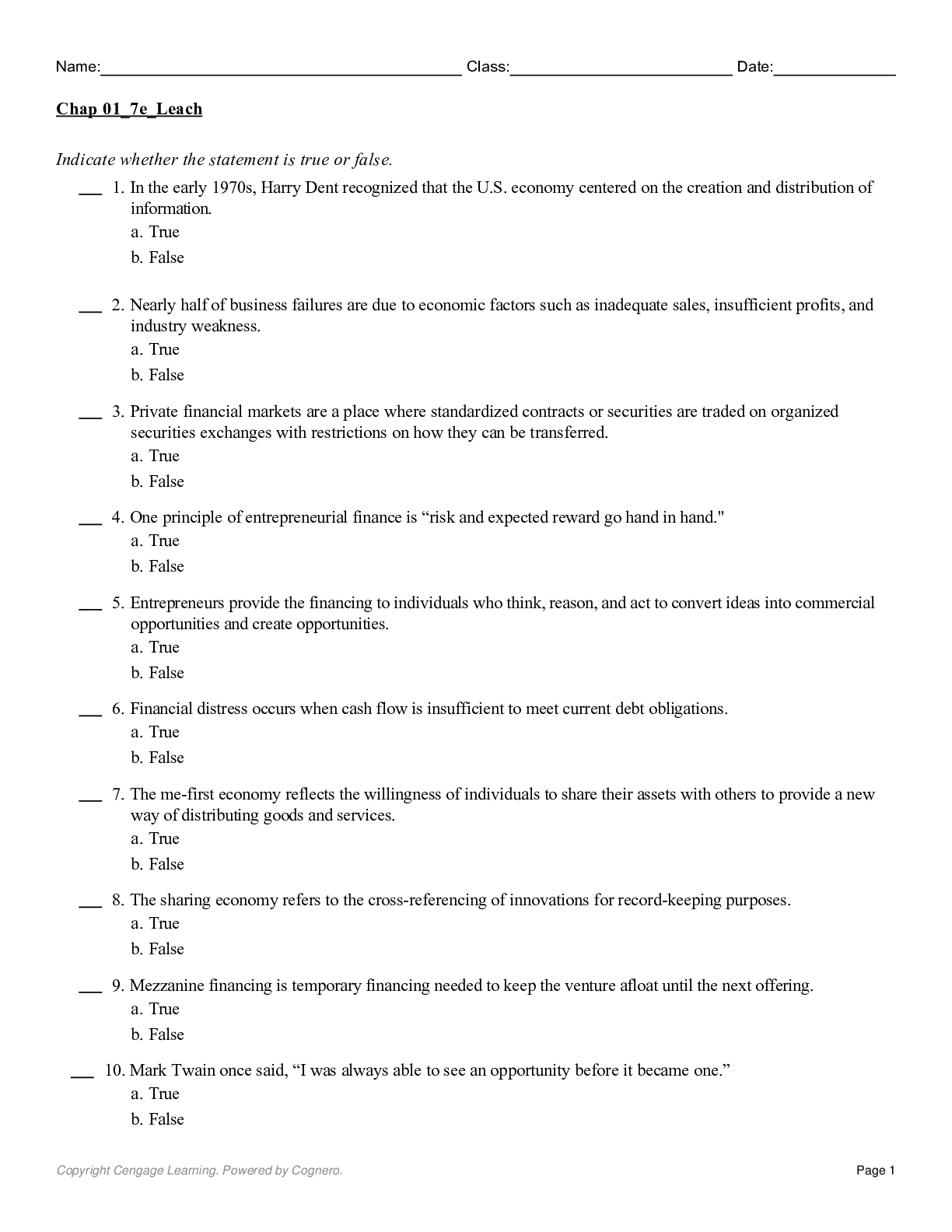
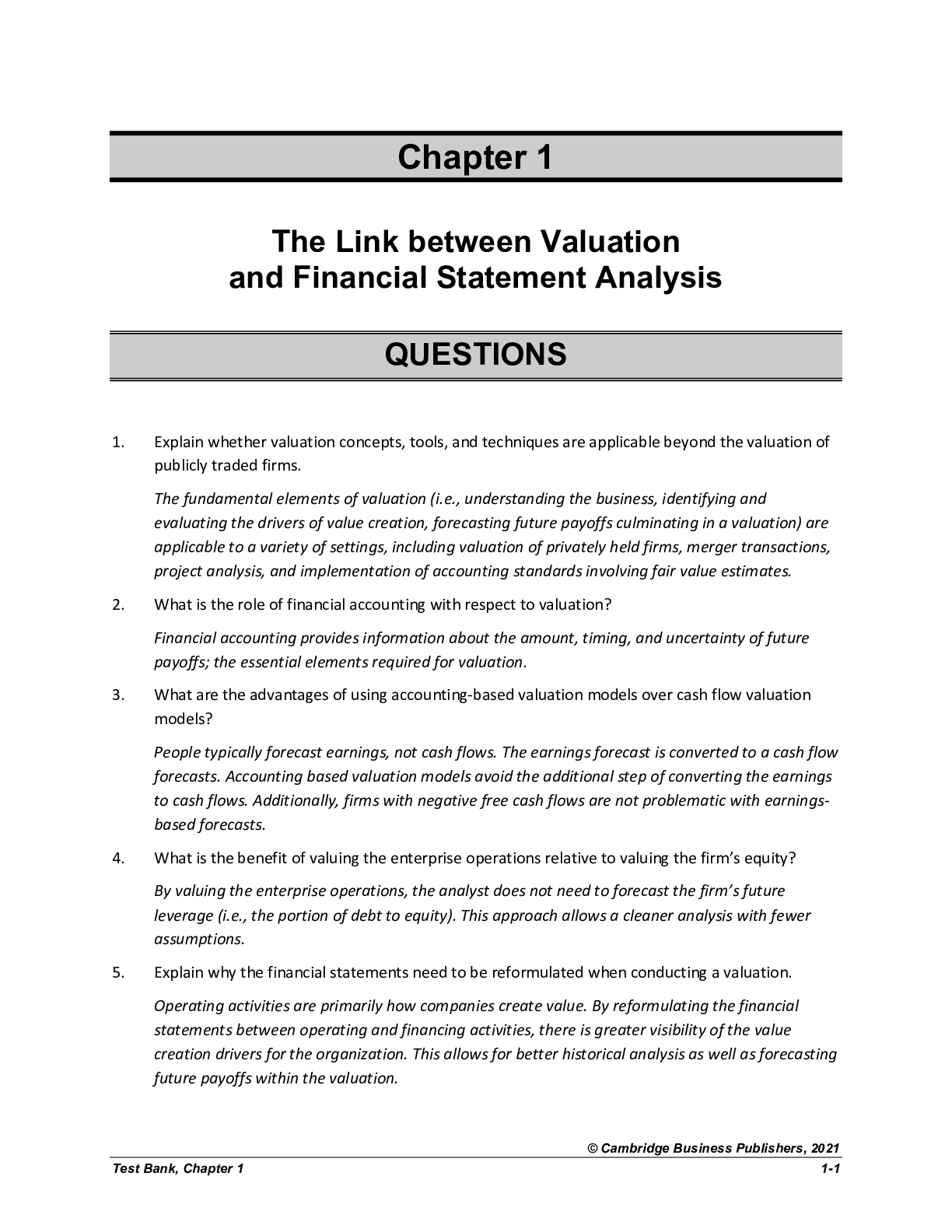

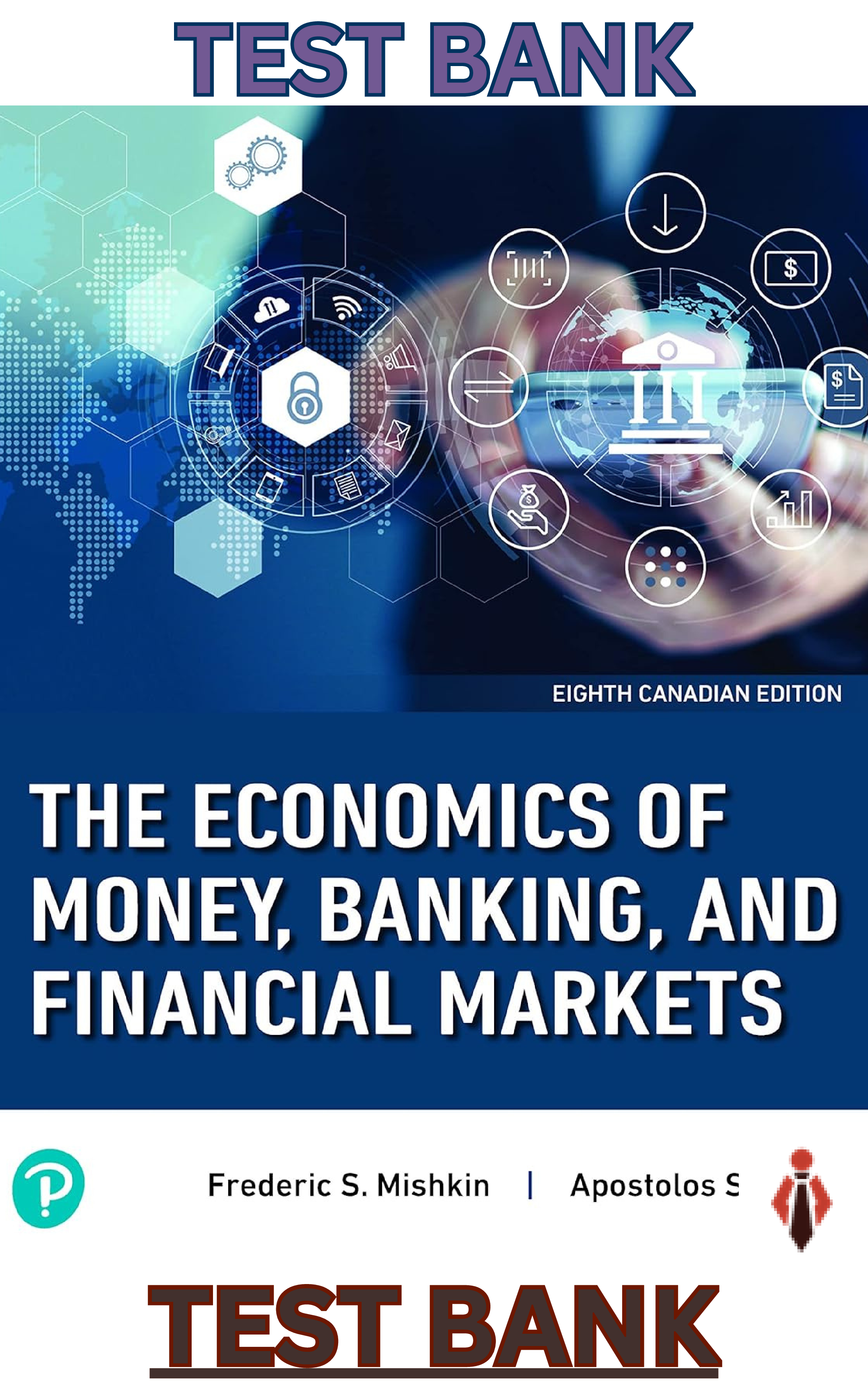



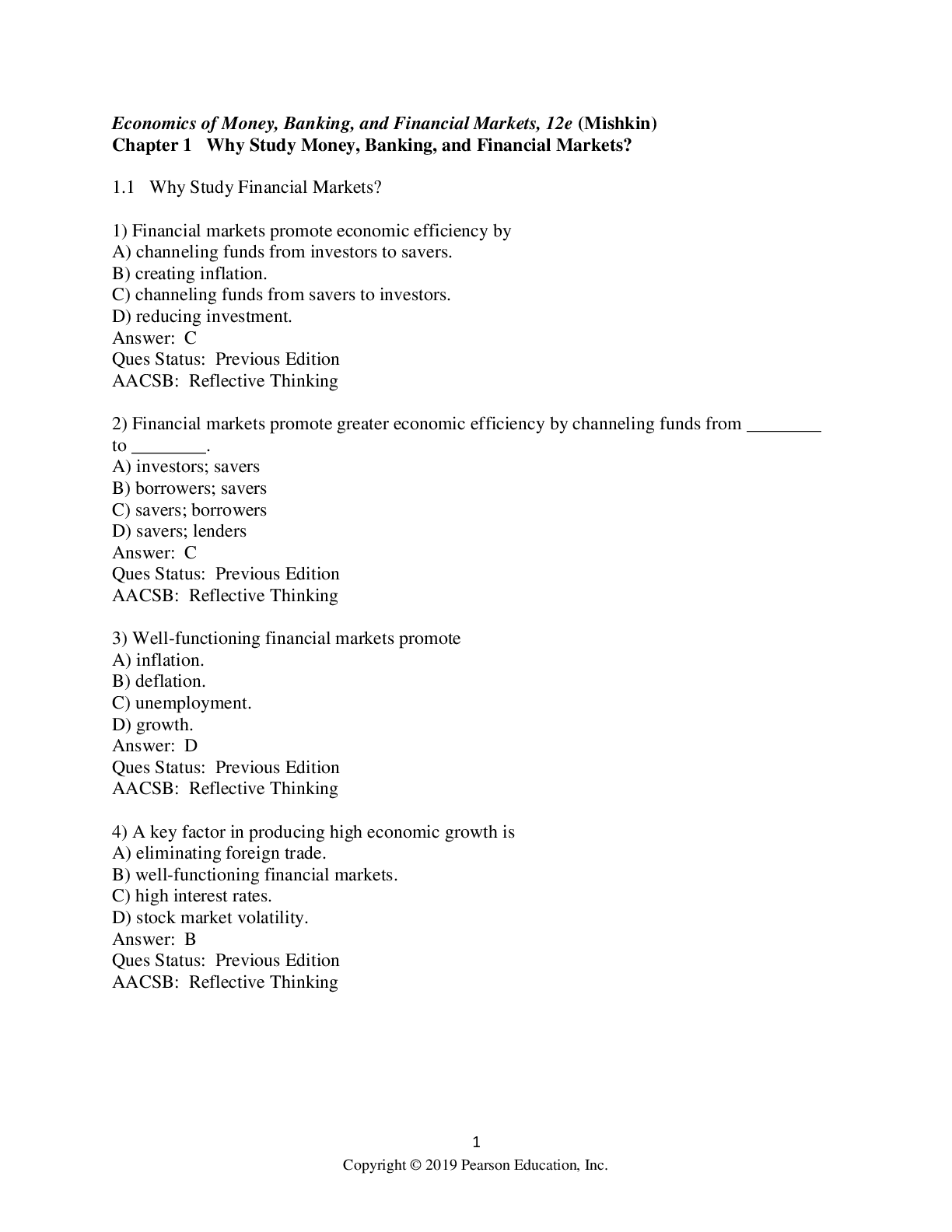
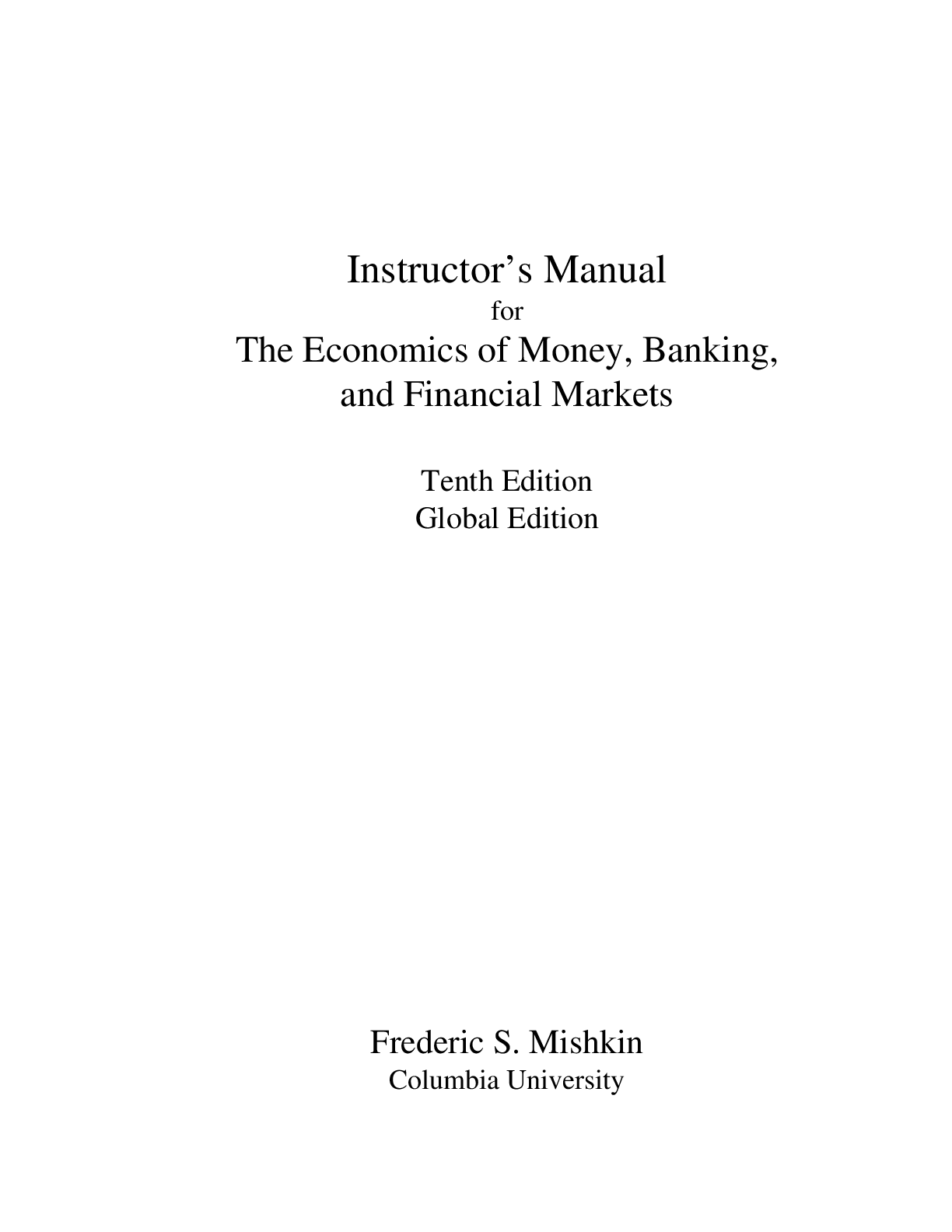

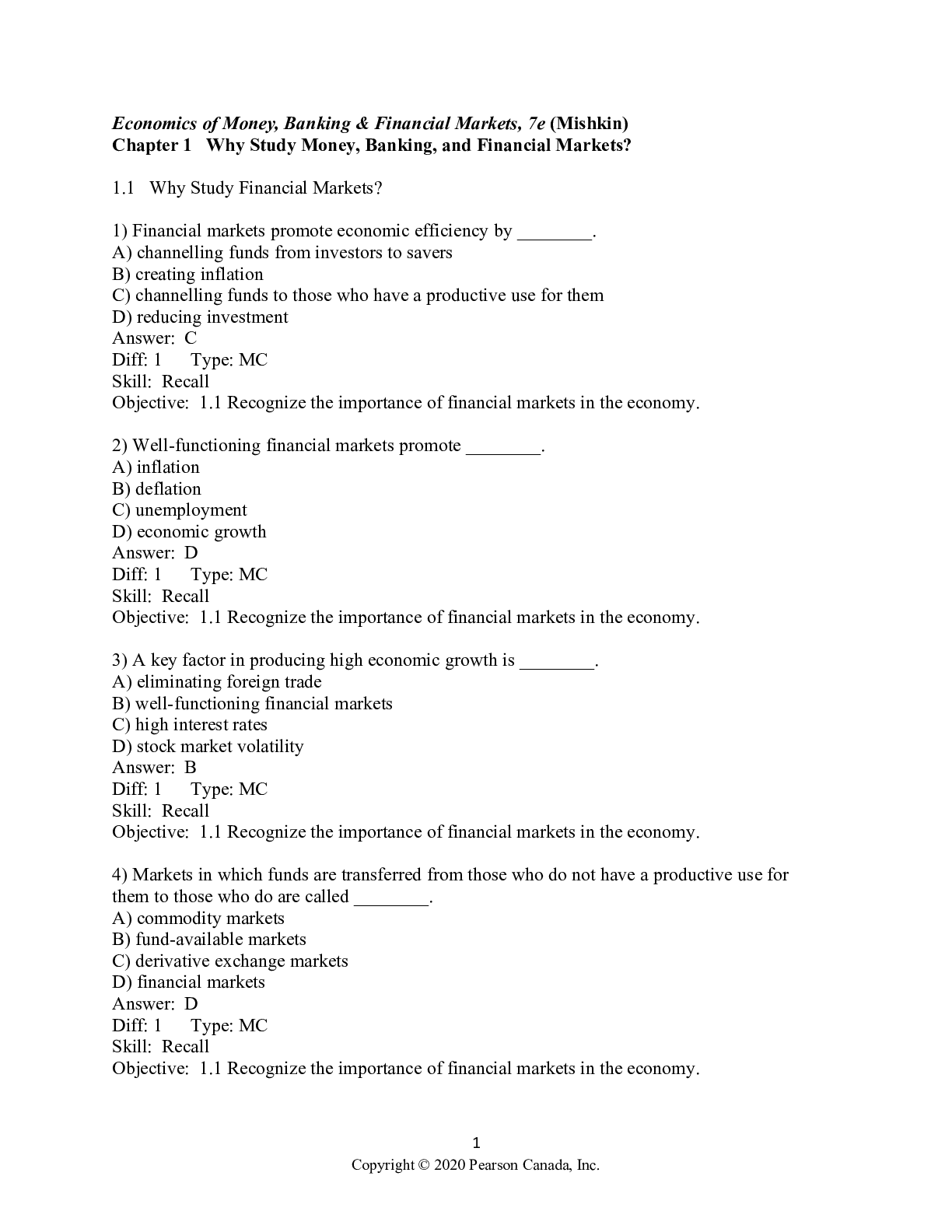
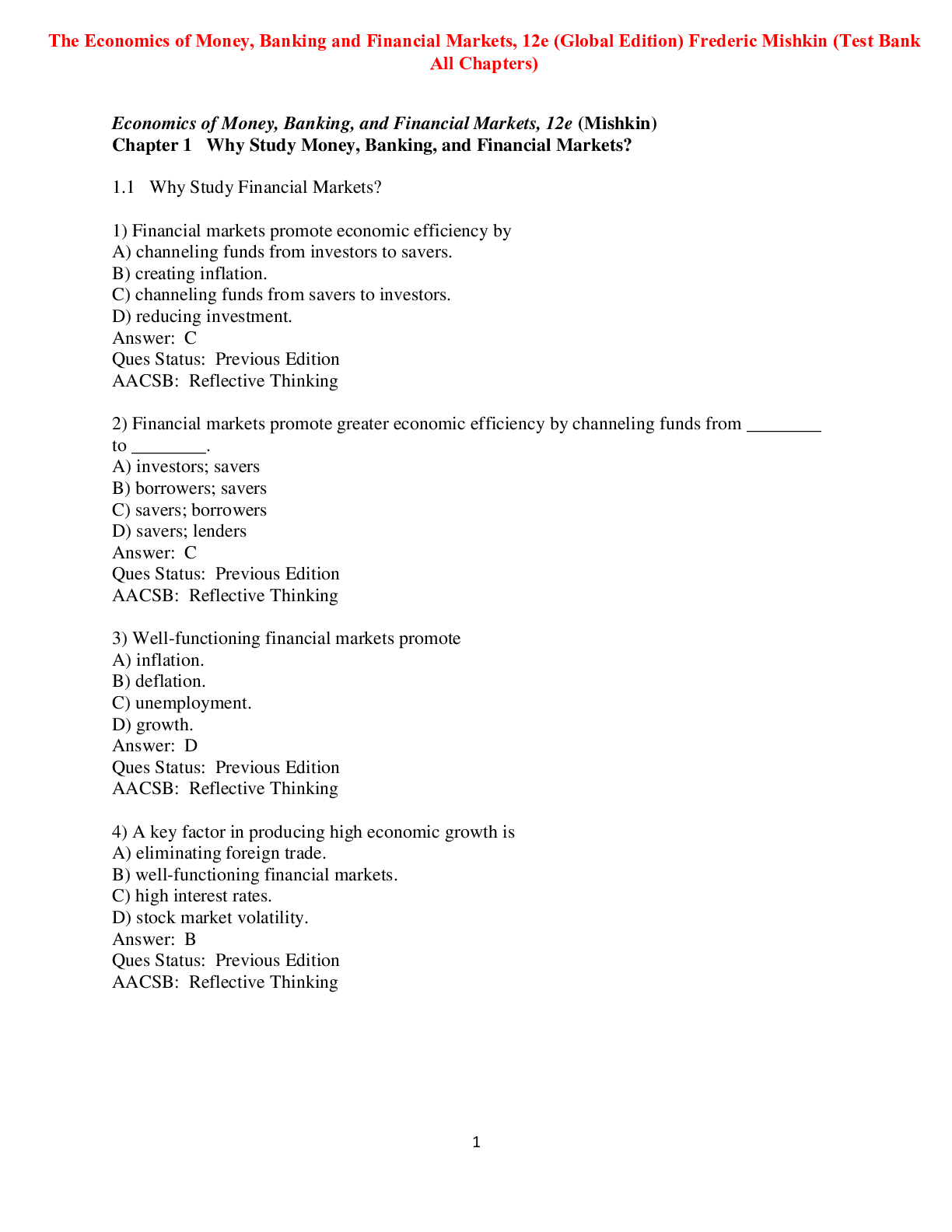
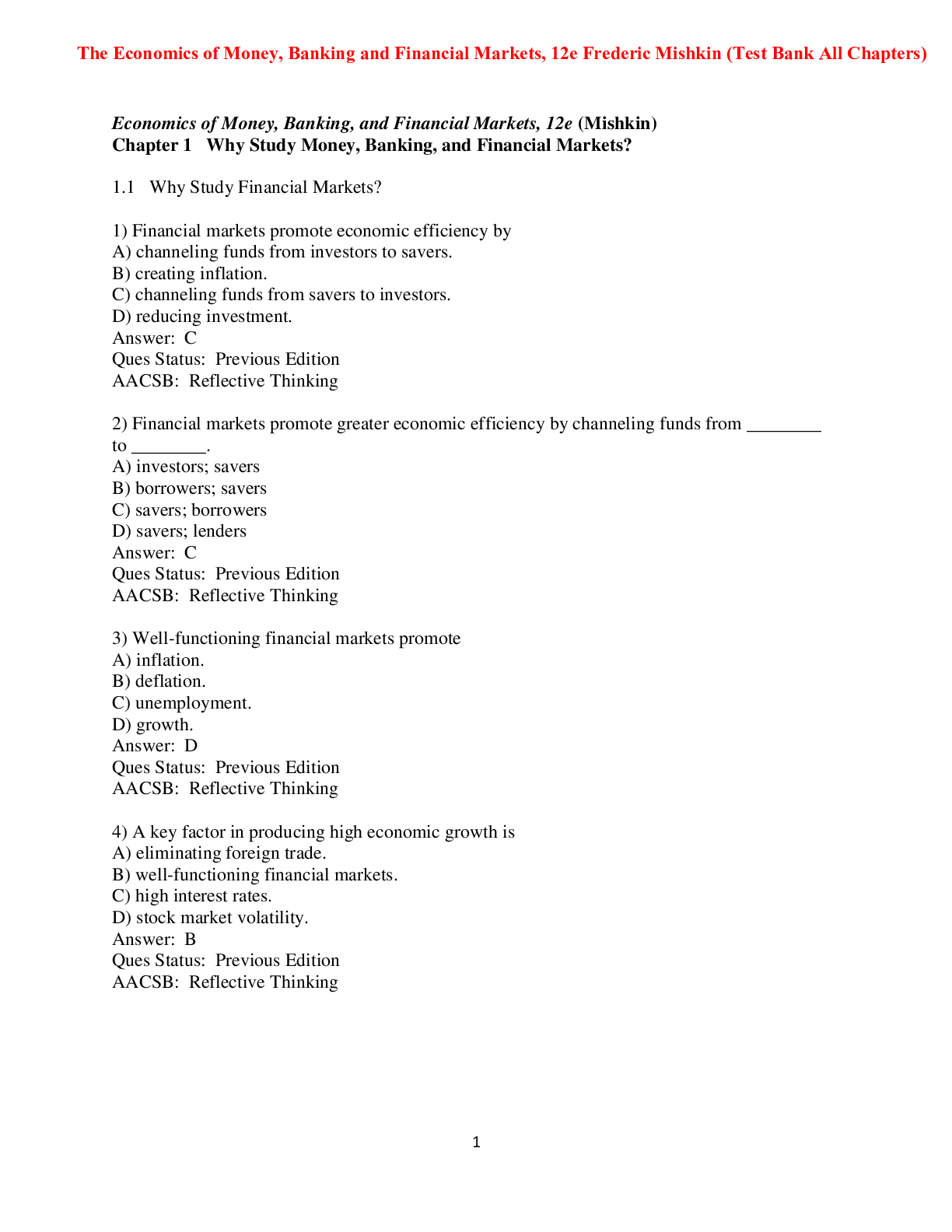

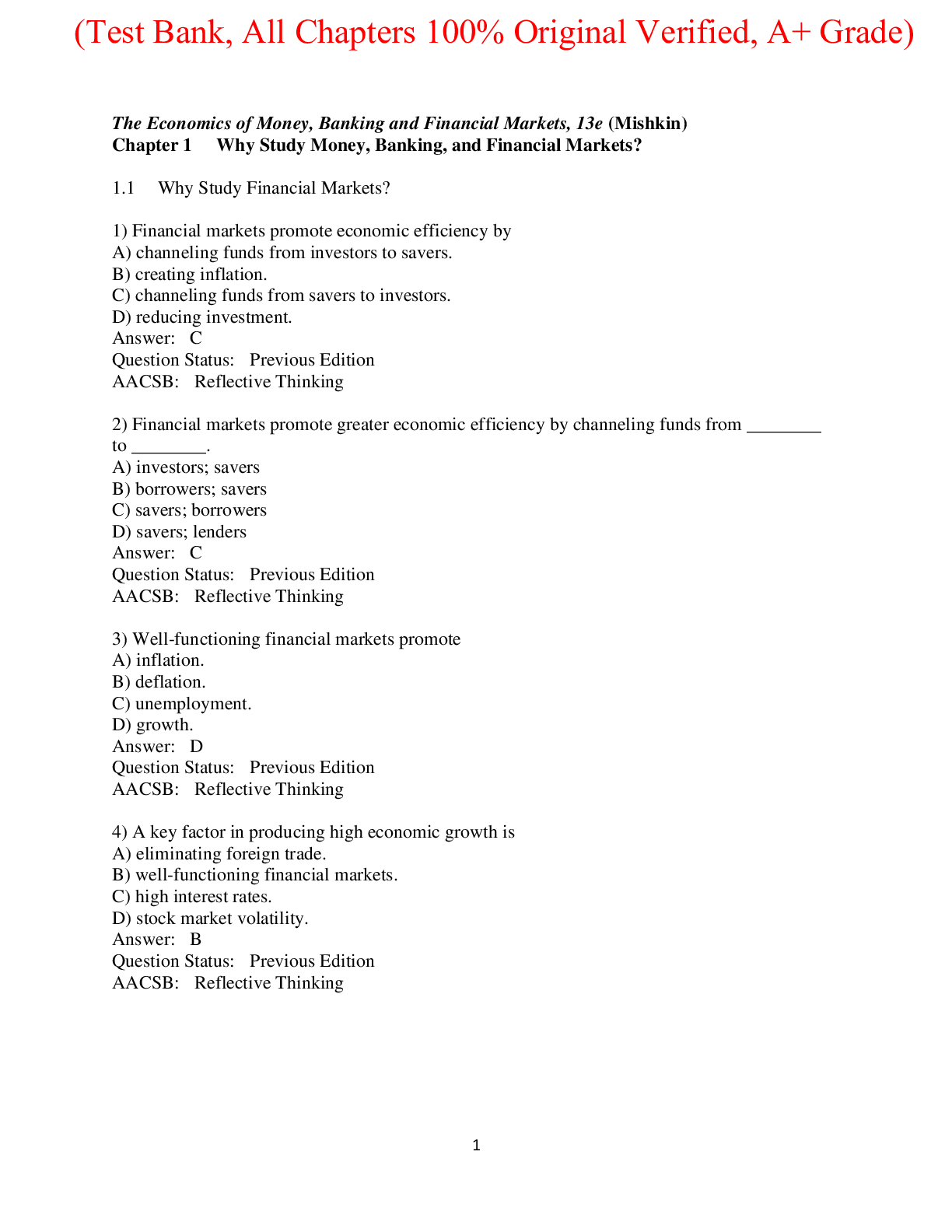
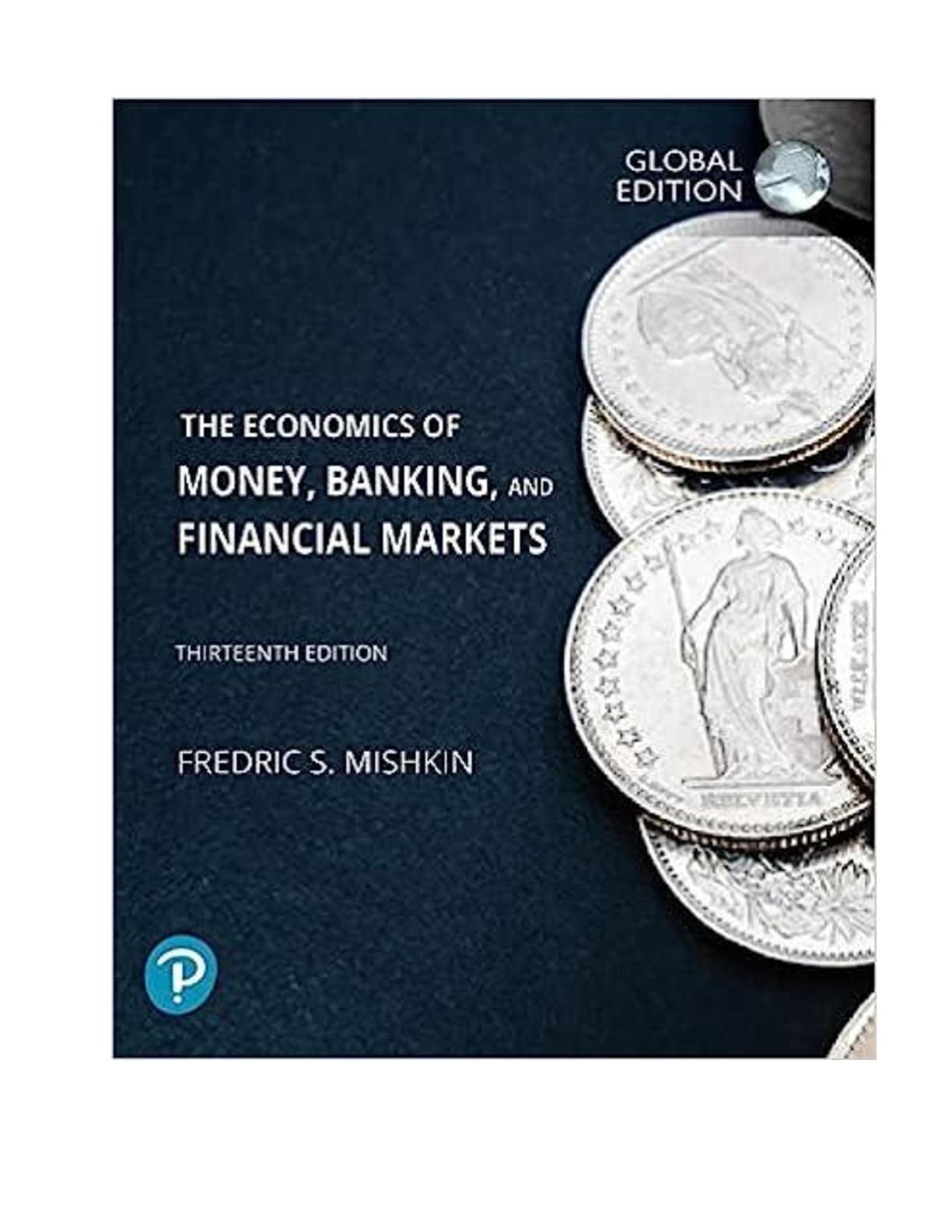
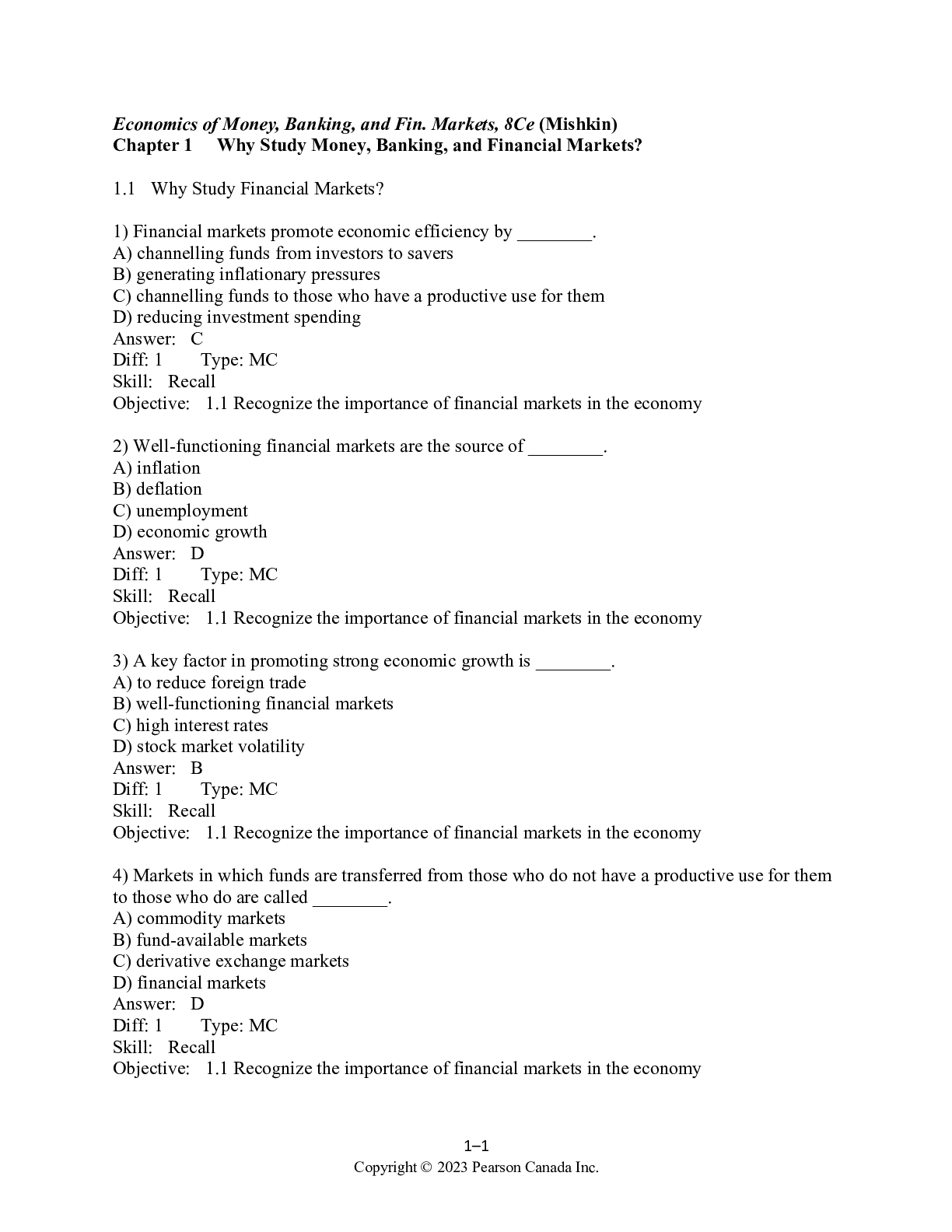
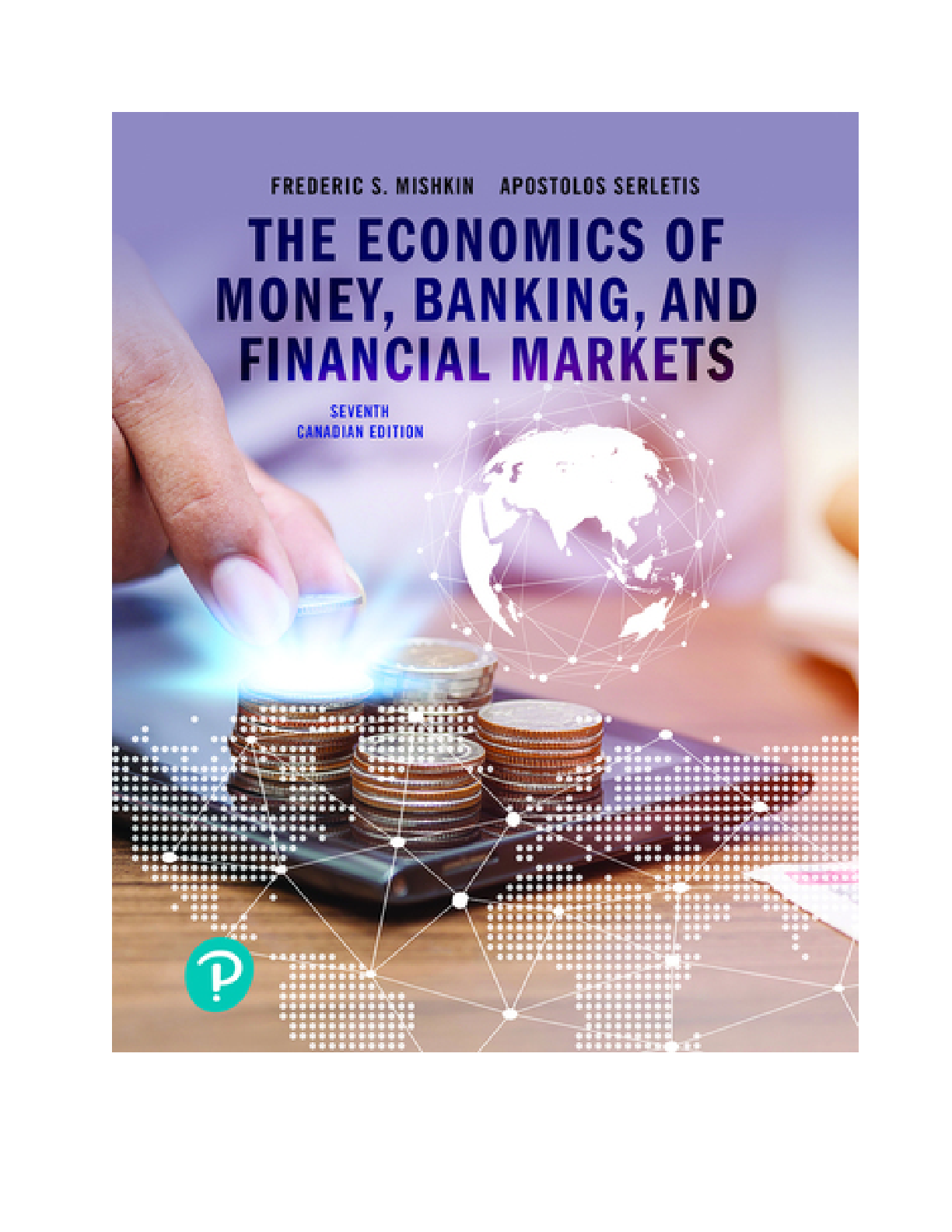
 by Frederic S.png)


